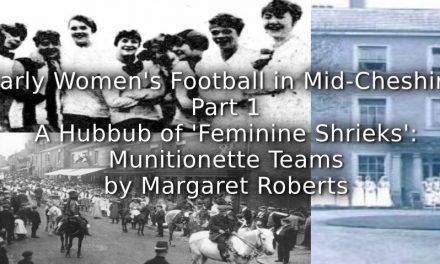The majority of the images are taken from Archivio personale Giuliana Bertea, courtesy of the player’s heirs/family – permission is needed to reproduce these images, please contact Playing Pasts for information.
For Part 1 of this series please click HERE
In May 2011, the former basketball player Giuliana Bertea died at the age of almost 90 years: she was born in the coastal town of Cervia in September 1921. Although she reached the peak of her career after WW2 (she was the Italian champion with Indomita Roma in 1949; in Italy’s line-up from 1948 to 1951, and played at the EuroBasket Women 1950), Giuliana started during the Fascist Ventennio, in one of the most significant cities for the regime power, as the late 1930s/early 1940s Rome was.
Some years before she died, Mimmo Cacciuni (Federazione Italiana Pallacanestro, FIP) and basketball historian Massimiliano Mascolo met the elderly Giuliana, who remembered her past and showed them the album she had kept, full of photographs and above all newspaper clippings. As Playing Pasts readers already know, this kind of material object was quite popular at that time among Italian girls, such as footballer Rosetta Boccalini (see https://bit.ly/3ww7YI9 ), ice skater Grazia Barcellona (see https://bit.ly/33kXjz4 ), athlete Gabre Gabric and Elda Franco all suggest (see https://bit.ly/3dkj3QI and https://bit.ly/3Le6h6o ). Thanks to the help of Mimmo Cacciuni (who at the time photocopied the album) together with the kind permission of Giuliana’s heirs, we can now take a look at the pictures of a sportswoman who lived two sporting lives, one before and the other after World War 2.
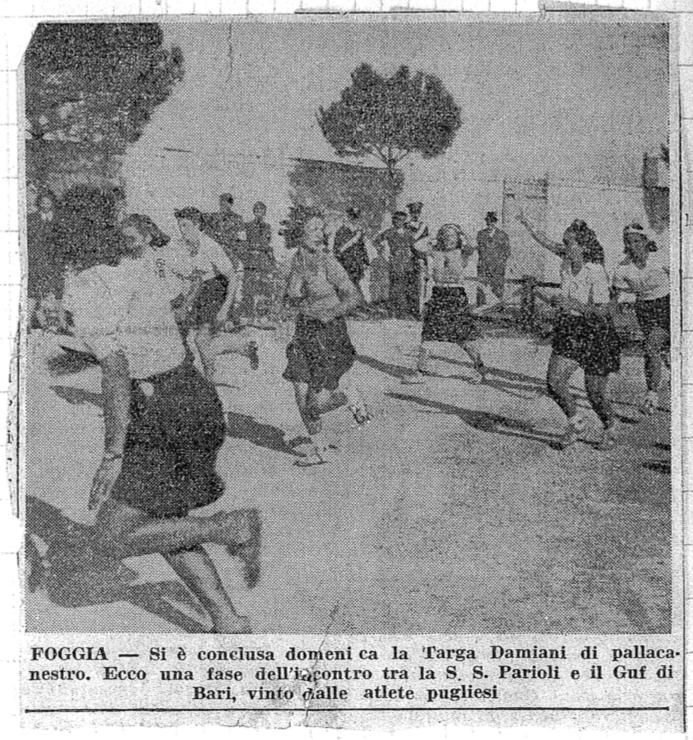
A match between Parioli and GUF Bari, probably during the summer of 1940
Source: Archivio privato Giuliana Bertea, p. 5.
Sometimes the clippings preserved in Giuliana’s album don’t follow a chronological order; and often they are not dated. After some complex work of reordering, we can date many of them, as you can see in the digital edition: https://sorelleboccalini.wordpress.com/le-fonti_larchivio-privato-giuliana-bertea/ . Although there are very few handwritten Giuliana’s notations, she divided her album into 4 main sections: the Parioli years (until 1941), the Bruno Mussolini years (1942-1943); the Indomita Roma years (1946-1952); the National team (1948-1950). A few times she underlined her name or added an arrow to identify herself in group pictures.
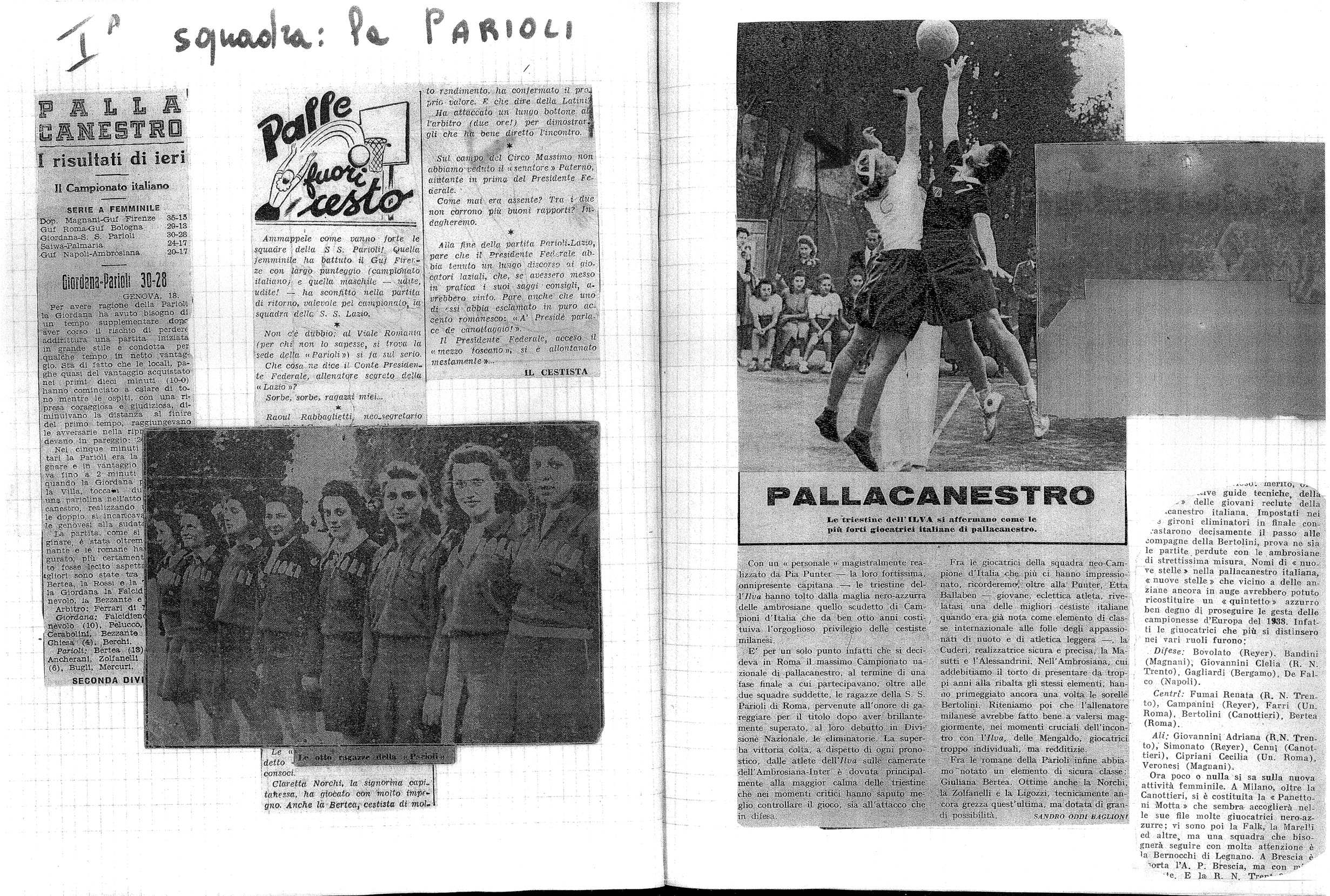
The first page of the Parioli years section
Source: Archivio privato Giuliana Bertea, p. 4.
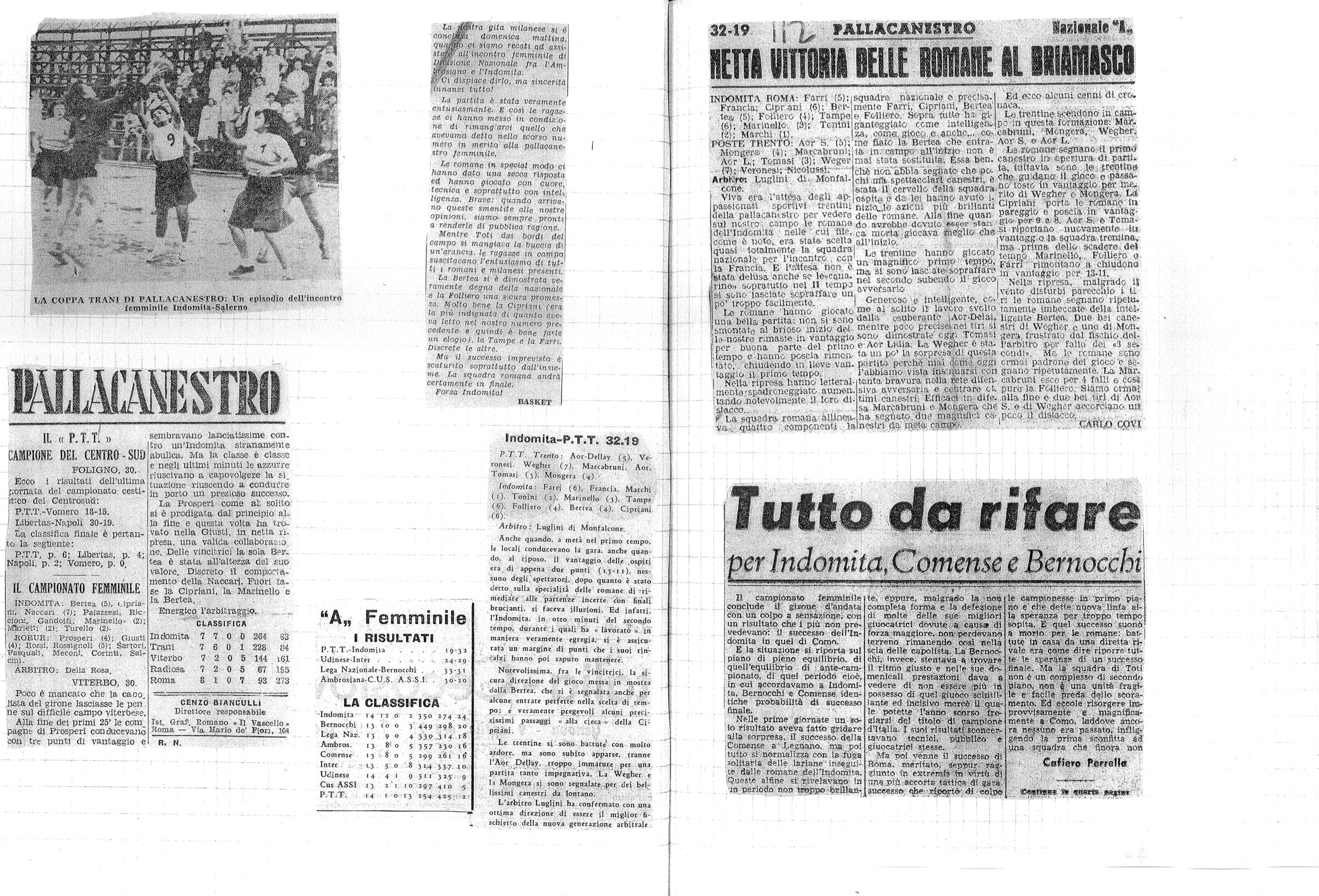
One of the first pages of the Indomita Roma section
Source: Archivio privato Giuliana Bertea, p. 9.
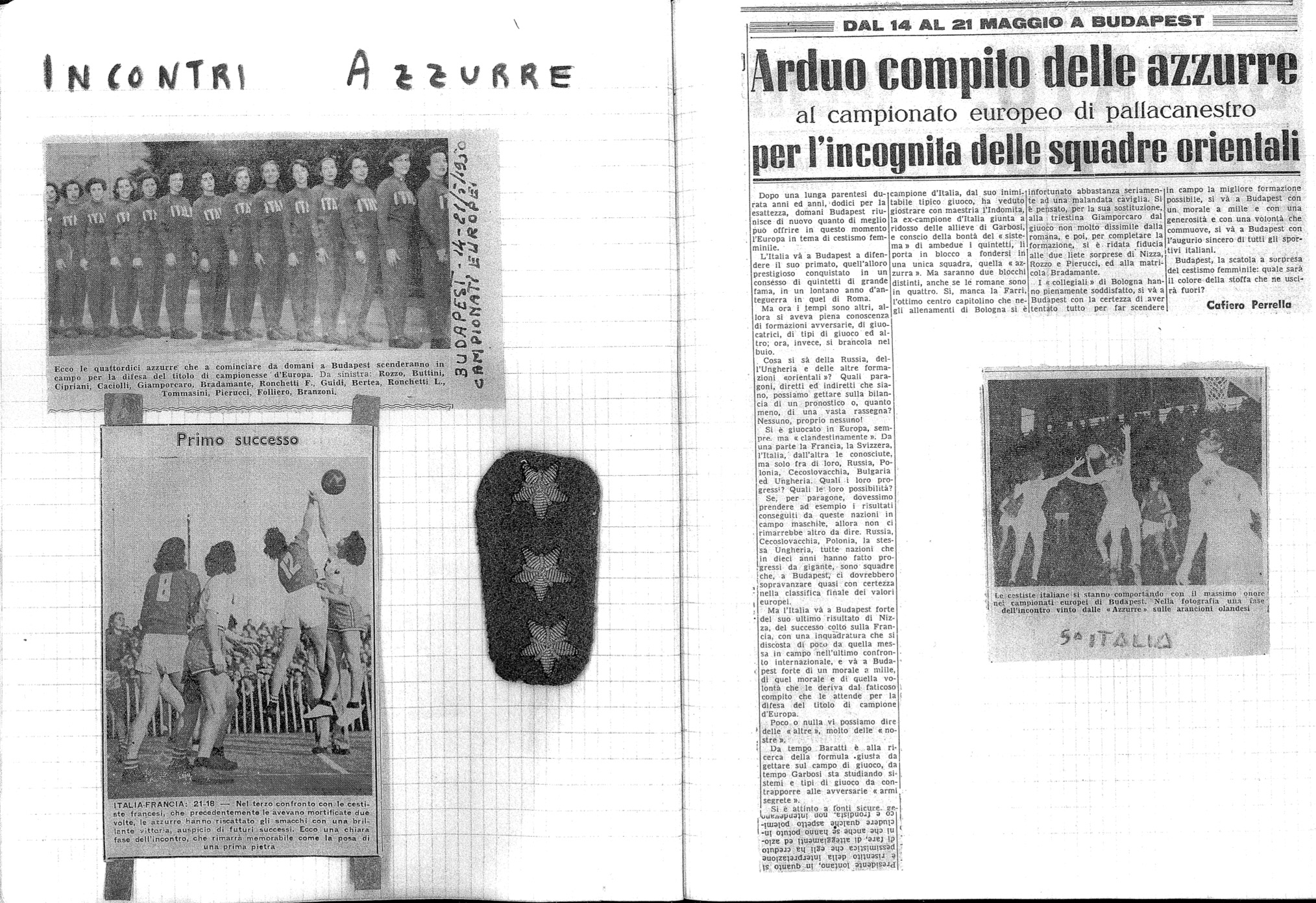
The first page of the National team section
Source: Archivio privato Giuliana Bertea, p. 9.
As written in Cenzo Bianculli’s article entitled “Se ci fosse una stella al merito GIULIANA BERTEA l’avrebbe guadagnata” (Summer 1951), which is a sort of Giuliana’s biography, she started to practice sports when she was already living in Rome, after her family’s move from Cervia. The Bertea family lived on the Gianicolo hill, a quarter that flourished during the Fascist Ventennio, thanks to the building of small houses for the capital city’s middle class.
-
A contemporary picture of Via Lorenzo Valla, in the Gianicolo quarter
Source: Google Maps
-
A small house in via Lorenzo Valla
Source: Google Maps
In a similar way to most of young females in mid-1930s Italy, Giuliana joined the regime’s youth associations, such as Giovani Italiane and Giovani Fasciste (see https://bit.ly/3tGhyGC ), which offered a wide range of sports to their members, especially in big cities such as Rome, which had many sports facilities.
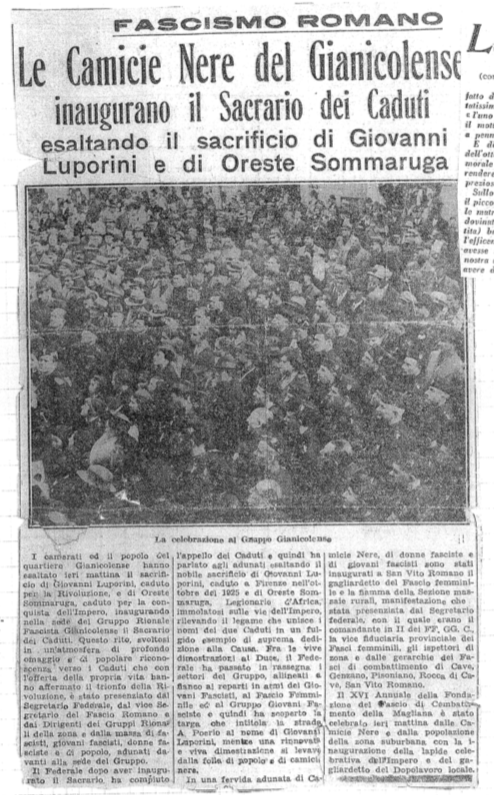
A clipping of an article about the inauguration of a monument to two Fascists fallen during the rise to power years (1919-1922) and during the Second Italo-Ethiopian war (1935-1936).
Since it was built by Gruppo Rionale Fascista Gianicolense, the Gianicolo quarter local Fascist group, all the internal groups joined the inauguration; among them, the Fasci Femminili (Fascist women) group and the Giovani Fasciste (18-22 working girls) group
Source: Archivio privato Giuliana Bertea, p. 23.
When she was 15 (1936) Giuliana began to practice athletics at Campo Lazzaroni, located in Tor di Quinto quarter, near a clay pit called Fornaci. It was far from Giuliana’s house, but she was happy to travel there with her team mates. She was very eclectic, competing in the discus, shot put, and 800m, and above all, she was good at sharing her love for sports with her peers.
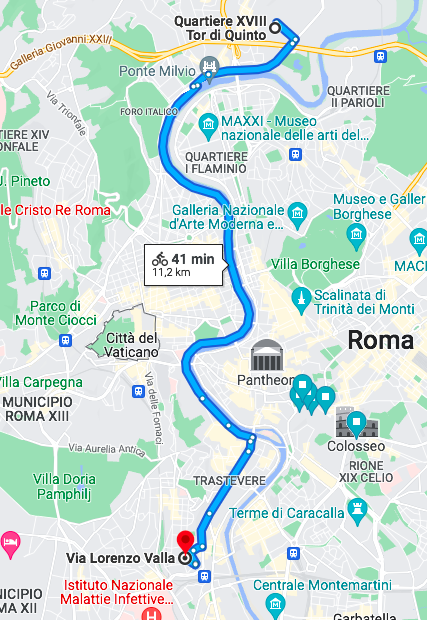
From Giuliana’s house to Campo Lazzaroni: a 40-minutes travel by bycicle, in Rome today …
Source: Google Maps.
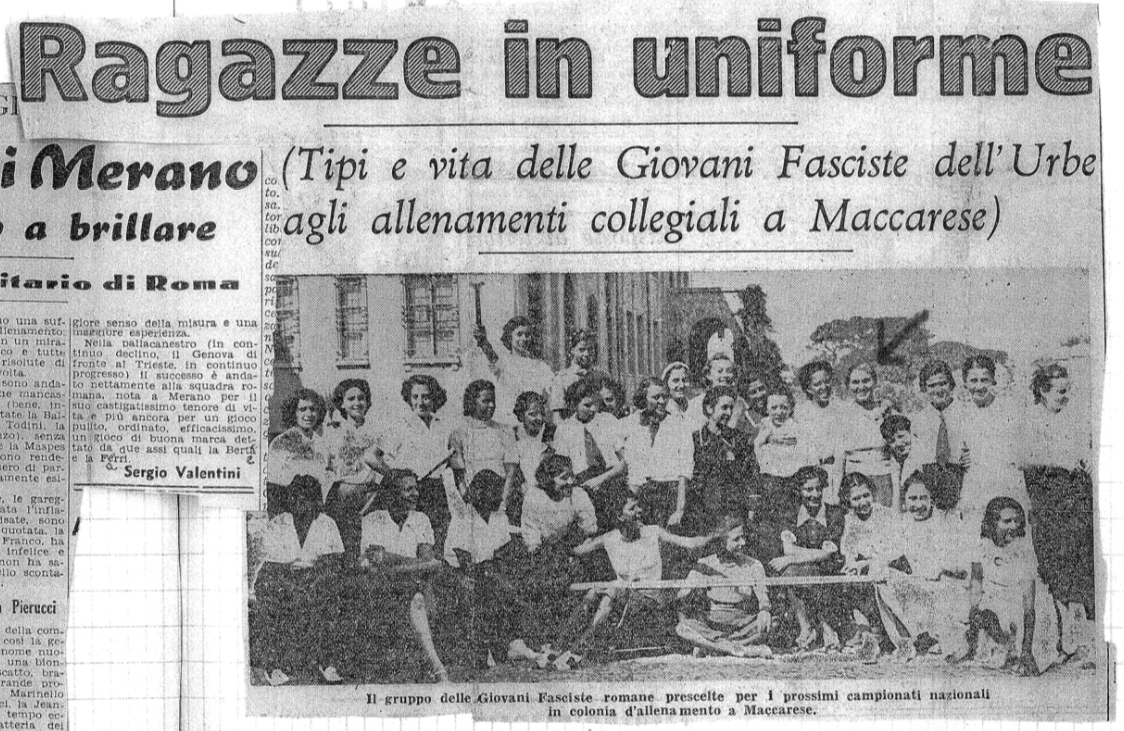
Giuliana (see the handwritten arrow) with her mates during training in Maccalese (near Rome) before the 1937 National Fascist Female Youth Championship
Source: Archivio privato Giuliana Bertea, p. 2.
Although Giuliana tried a lot of different sports such as athletics, it was inevitable that she would become a basketball player, thanks to her powerful body and her height (she was 1.70m/5’10 inches – tall). Nevertheless, it took her a while to understand that her future wasn’t in athletics, but basketball: in the early years, she just played for fun with her friends at the athletics club…
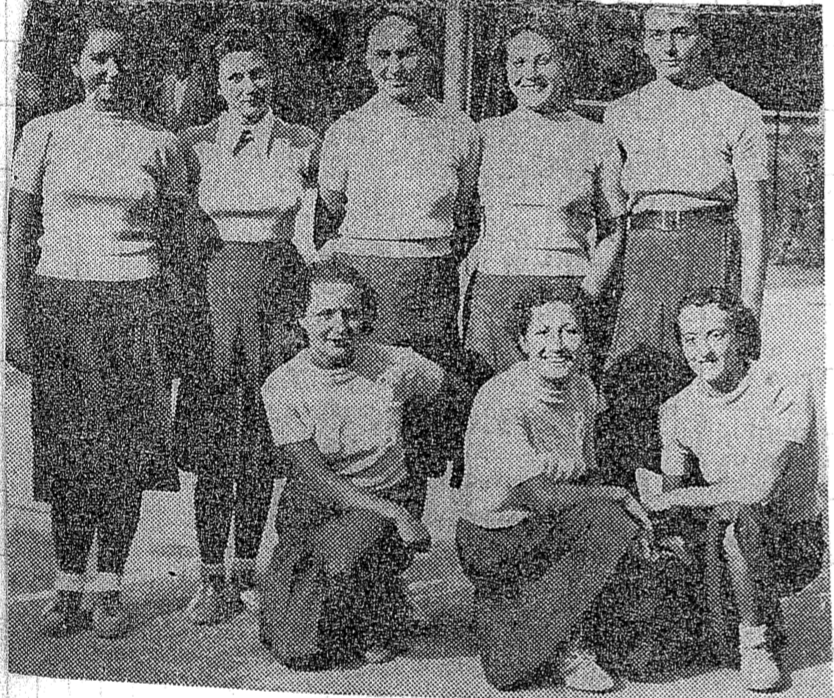
The Giovani Fasciste team from Rome (1937)
Source: Archivio privato Giuliana Bertea.
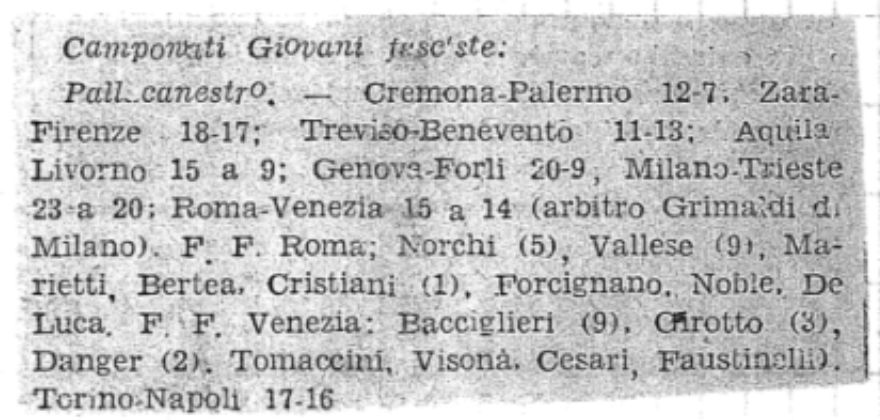
Thanks to this clipping , we can reconstruct the Giovani Fasciste team from Rome 1937 line-up
Norchi, Vallese, Marietti, Bertea, Cristiani, Forcignano, Nobile, De Luca
Source: Archivio privato Giuliana Bertea.
Before continuing with Giuliana’s story, let’s talk for a while about the women’s basketball movement in 1930s’ Rome. According to Massimiliano Mascolo’s Almanacco del basket al femminile (2nd edition, 2016), the 1935 Società Sportiva Parioli team who played in Divisione Nazionale was composed of Clara Norchi, Elena Giandolini, Tina Rovelli, Alba Cerofolini, Emma De Rosi, F. De Santis, while Angelo Bovi was the coach. From 1934 to 1939 the main womens’ team from Rome was Ginnastica Roma: thanks to players such as Flaminia Theodoli, Carla Parodi Delfino, Vittoria Ceriana Mayneri and Elena Migliore, the team always played in Divisione Nazionale during the second part of the 1930s, while SS Parioli was surviving in the minor championships.
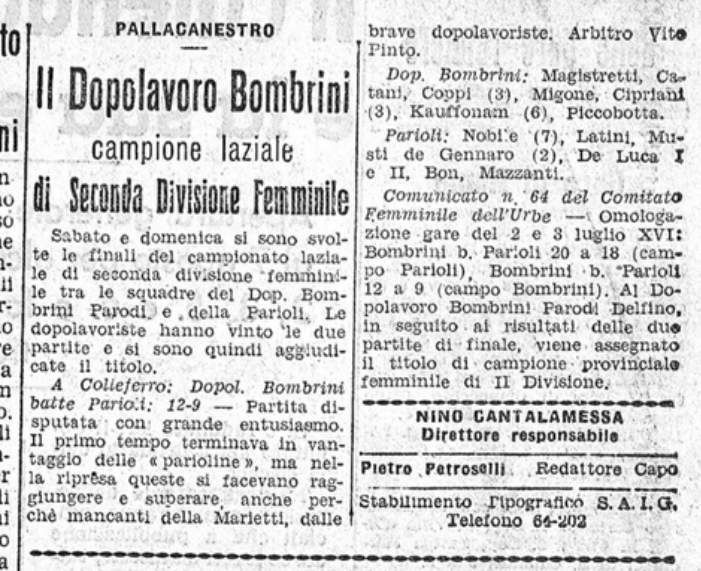
An article about the final match of Seconda Divisione of Lazio region, between Parioli and Dopolavoro Bombrini
The SS Parioli line-up was Nobile, Latini, Musti De Gennaro, De Luca I, De Luca II, Mazzanti
Source: Il Littoriale, 07/07/1938, p. 8.
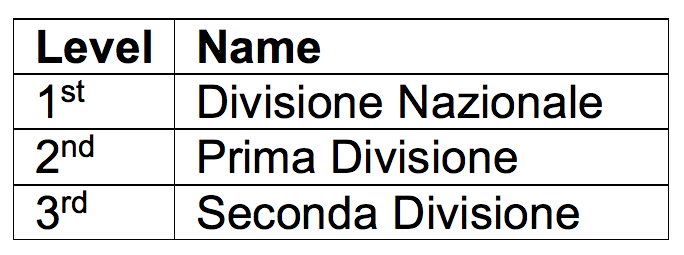
A table useful to understand the level of the 3 women’s basketball championships in 1930s’ Italy.
Nevertheless, during those years, the Parioli sports society had an incredible media over-exposure. The first reason might be found in its location: since Rome was the leading centre of the national media industry and the regime’s propaganda, filming or taking a picture of Parioli’s basketball players was very simple. Adding to this …in about 1935 the players wore a very nice light polka dots shirt!
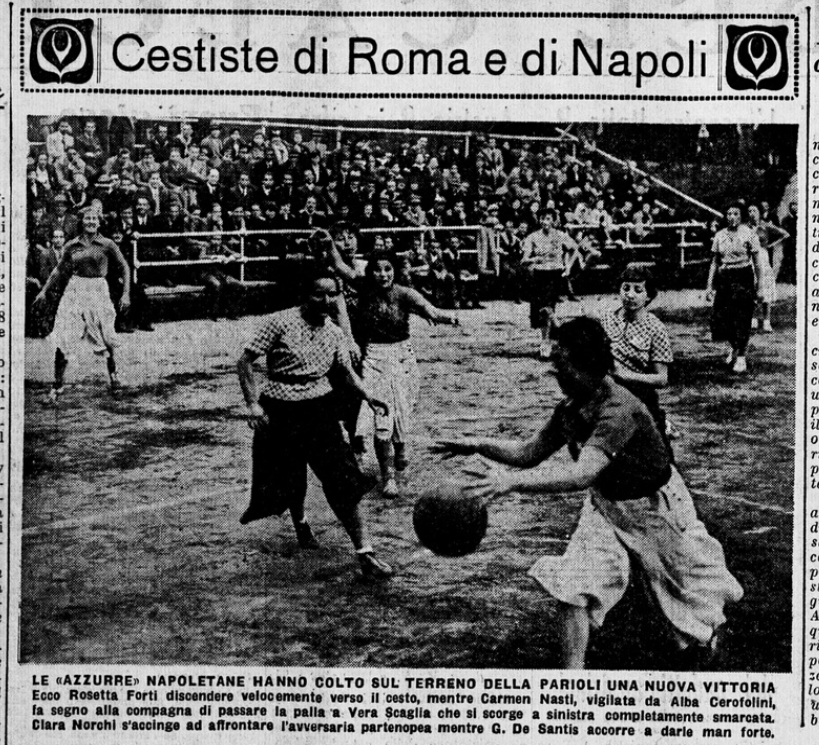
A Napoli – Parioli match, in March 1935; the Roman players depicted are Alba Cerofolini and Clara Norchi
Source: Il Littoriale, 26/03/1935, p. 4
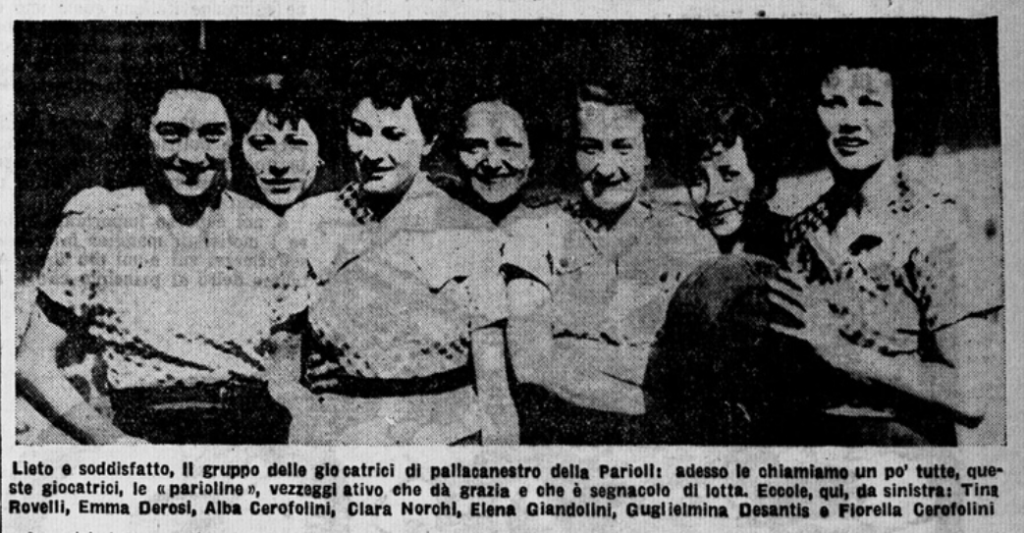
The Parioli team line-up (1935): Tina Rovelli, Emma Derosi, Alba Cerofolini, Clara Norchi, Elena Giandolini, Guglielmina Desantis, Fiorella Cerofolini
Source: Fonte: Il Littoriale, 09/03/1935, p. 7.
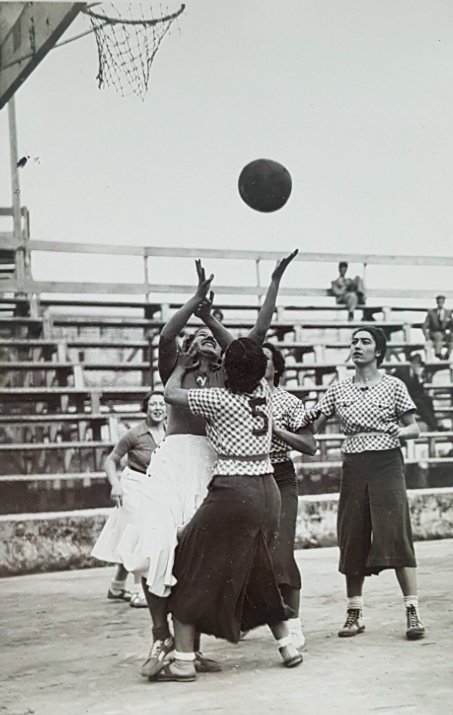
Napoli – Parioli (no date)
Source: https://twitter.com/calciatrici1933/status/1079366661189316608
The second reason was the number of social relations with journalists, VIPs, and Fascist officials that middle and higher-class Roman sportswomen such Ginnastica Roma and SS Parioli players had. In order to better understand it, let’s take the example of a 1940 article about the skiing activity of those internal to SS Parioli – please remember that the Parioli quarter is still one of the most elite neighbourhoods of Rome, and in the contemporary Italian language pariolino (f. pariolina) means ‘posh’. From 1st to 3rd of March 1940 SS Parioli would organize the National Women’s Ski Championship at the Monte Terminillo ski resort, entering in the race a lot of it’s members, such as Nives dei Rossi (1st category), Ruth Graffer (2nd category), Ginevra dei Rossi, Gemma dei Rossi, Adele Marazza, Lola Berardelli, Adele Niccolini, Rosa Provenzani, Caterina Franzi, Vittoria Franzoni, Anna Maria Baccelli, Nora Calcis and Ester Alliata. The Il Littoriale journalist then wrote about the absence of Enrica “Pupa” Musti De Gennaro, who had a cast on her foot due to a broken ankle: otherwise, in his opinion she would have been able to win the 3rd category title.
- Source: Il Littoriale, 23/02/ 1940, p. 3
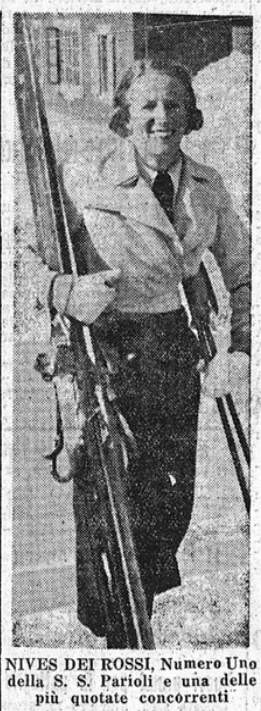
Nives dei Rossi
Number 1 from Parioli, and one of the most valued competitors in the 1940 National Women’s Ski Championship
Source: Il Littoriale, 29/02/1940, p. 1.
Since a lot of Italian surnames beginning with either ‘Di’ or ‘Dei’ are of noble origin, you realize that a lot of Parioli skiers (such as sisters Dei Rossi) were from noble and higher-class families. Add to this, the presence of Enrica Musti De Gennaro is even more interesting. In 1938 the Roman sports newspaper Il Littoriale published an article about the women’s Prima Divisione finals, which is quite strange, since the anonymous author (‘M. M. d. G.’) seems to be very close to the Ginnastica Roma players, sharing with his readers many details about them. Since in 1939 Domenico Musti De Gennaro, whose nickname was “Mimmo”, was on the board of SS Parioli (see https://www.lazio900.it/oggetti/136777-societa-sportiva-parioli-musti-de-gennaro-mimmo-a-ugo-spirito/ ) we can imply that he was the author of this article: was Enrica his sister, or his cousin?
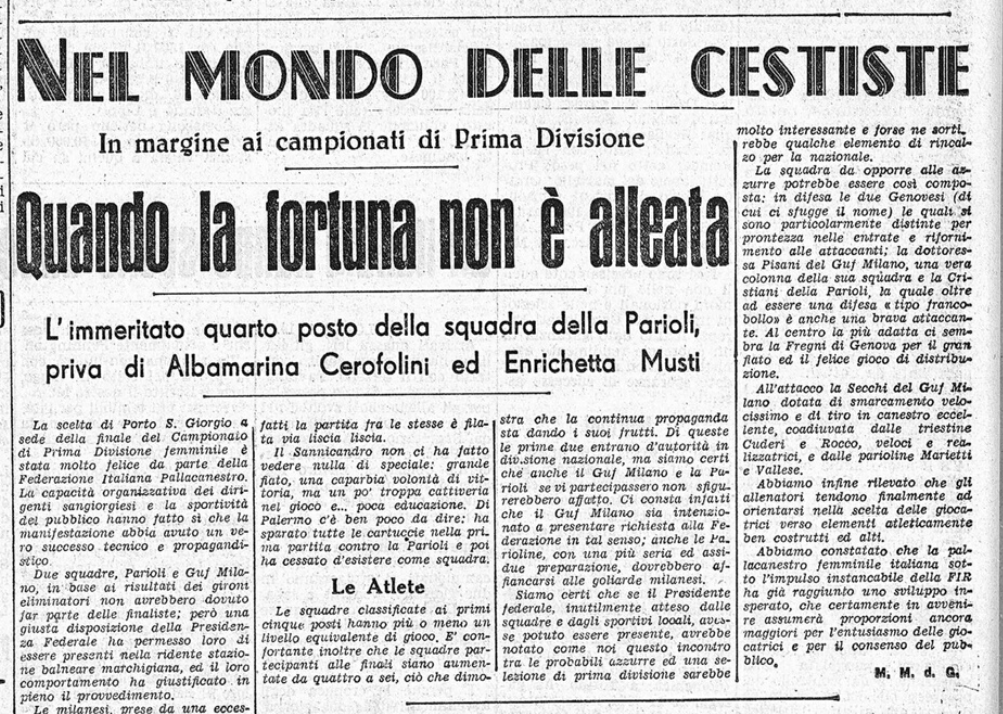
Source: Il Littoriale, 15/07/1938, p. 8.
Born in 1912, Domenico shared his basketball passion with his friend Bruno Mussolini; and Coppa Bruno Mussolini was probably the most important Roman basketball tournament (both for women and men) of that age. As known, both Mussolini’s eldest sons, Vittorio (b. 1916) and Bruno (b. 1918) were fond of sports.
In Winter 1935 Bruno Mussolini founded the Società Sportiva Parioli, a new sports club for the high class Roman people: Domenico De Musti was appointed as Direttore Generale (see http://www.sciclubterminillo.it/file_testo/Storia%20Atleti%20del%20Terminillo.pdf ).
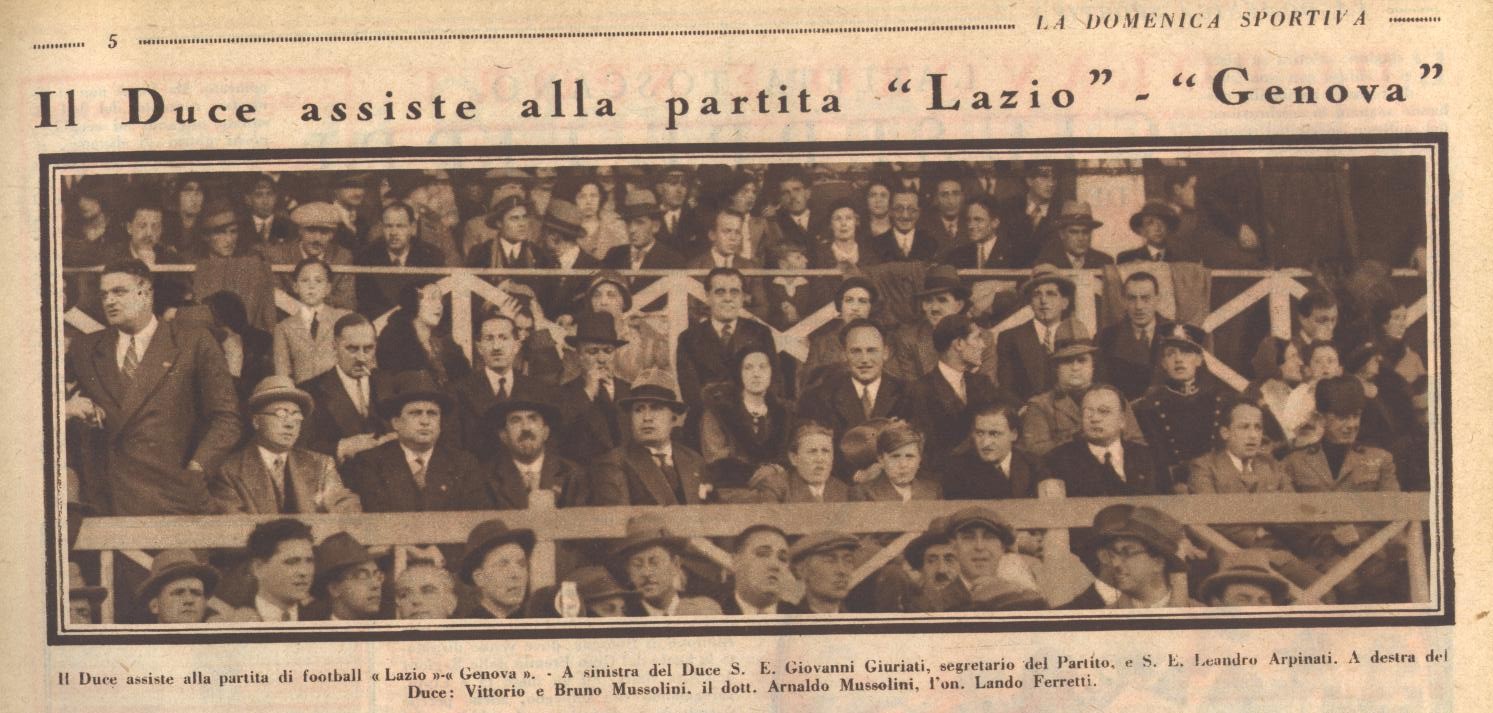
Benito Mussolini attending the football match Lazio – Genoa in November 1930
On his right, his young sons Vittorio and Bruno, and his brother Arnaldo
second on his left is Leandro Arpinati, the Fascist leader who three years later gave permission for the Gruppo Femminile Calcistico to play football (see https://www.playingpasts.co.uk/articles/football/historical-treasures-from-milan-archivio-di-stato/ )
Source: La Domenica Sportiva, 23/11/1930, https://www.romasportspettacolo.it/ma-la-lazio-era-fascista/
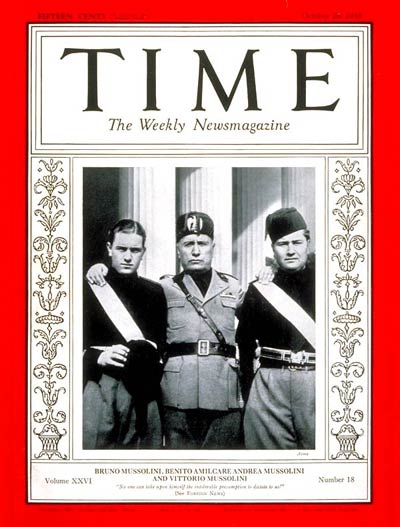
A 1935 Time cover: Bruno, Benito and Vittorio Mussolini
Source: ACME, Public domain, via Wikimedia Commons
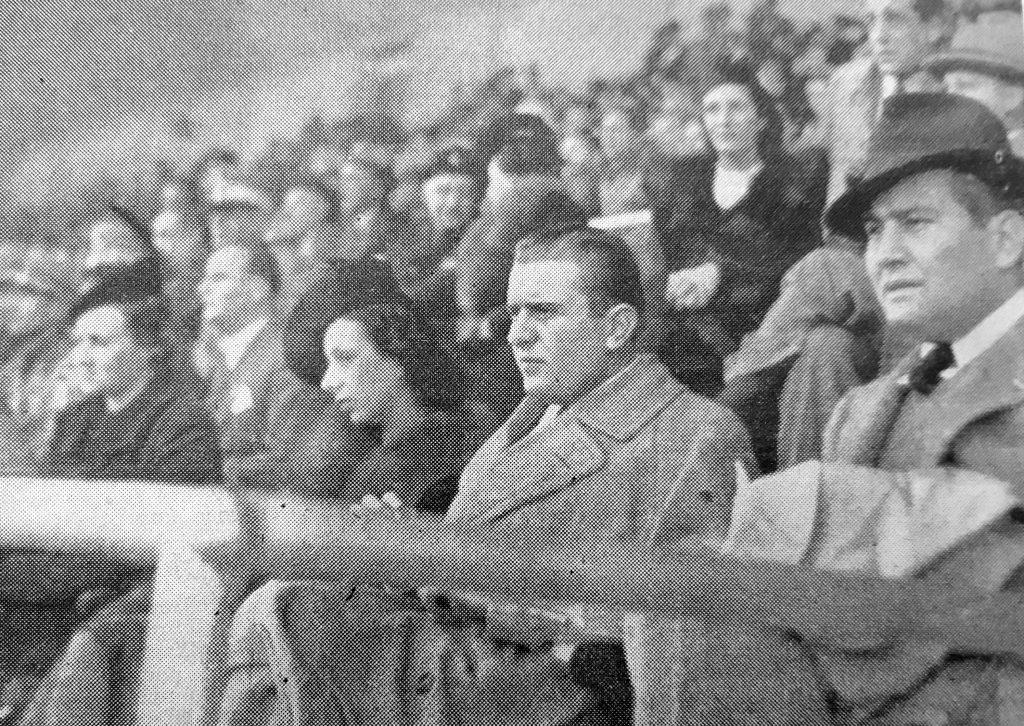
Bruno and Vittorio Mussolini with their wives Gina Ruberti e Orsola Buvoli, during the football match Italy – France, Naples (December 1938).
Source: Unknown author, Public domain, via Wikimedia Commons
The link between Bruno Mussolini and basketball was so clear that even before his death (1941) the national tournament Coppa Bruno Mussolini was organized in Rome. Since it had also a women’s section, both Ginnastica Roma and SS Parioli were able to join.
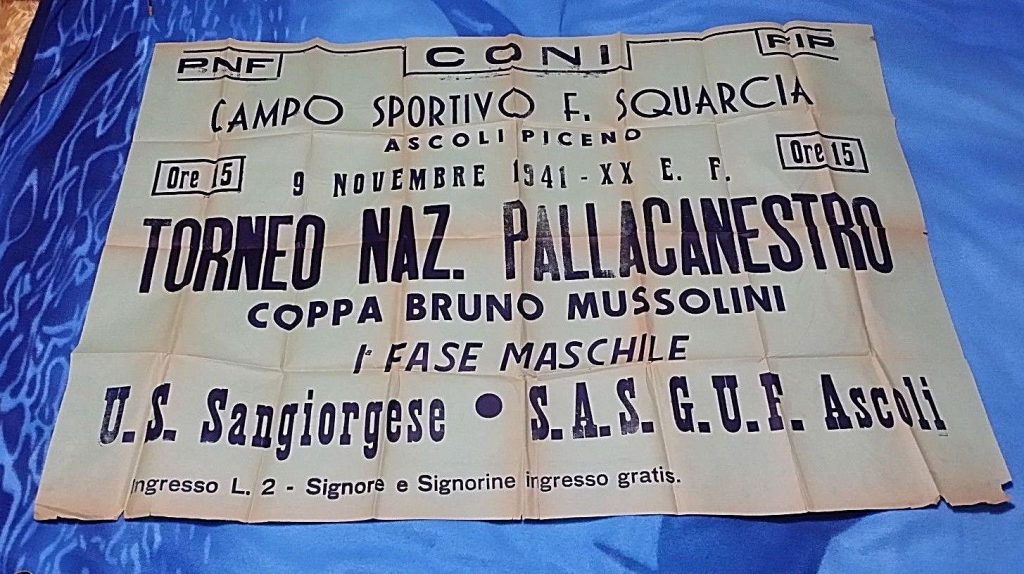
Coppa Bruno Mussolini was a National tournament, with local eliminatory rounds: in this case, two men’s teams played in Ascoli for the 1941 edition
Please note the last line: ‘free entry for girls and ladies’
Source: https://www.ebay.it/itm/273015062612 .
The eliminatory rounds of Coppa Bruno Mussolini (December 1937): the first team is Parioli. Source: https://youtu.be/H-ORAvFa-mY
Parioli – OND Bomprini Parodi (13-8), played in Rome for the 4th edition of the Bruno Mussolini Cup (March 1938).Source: https://youtu.be/tx-da1wiBWI .
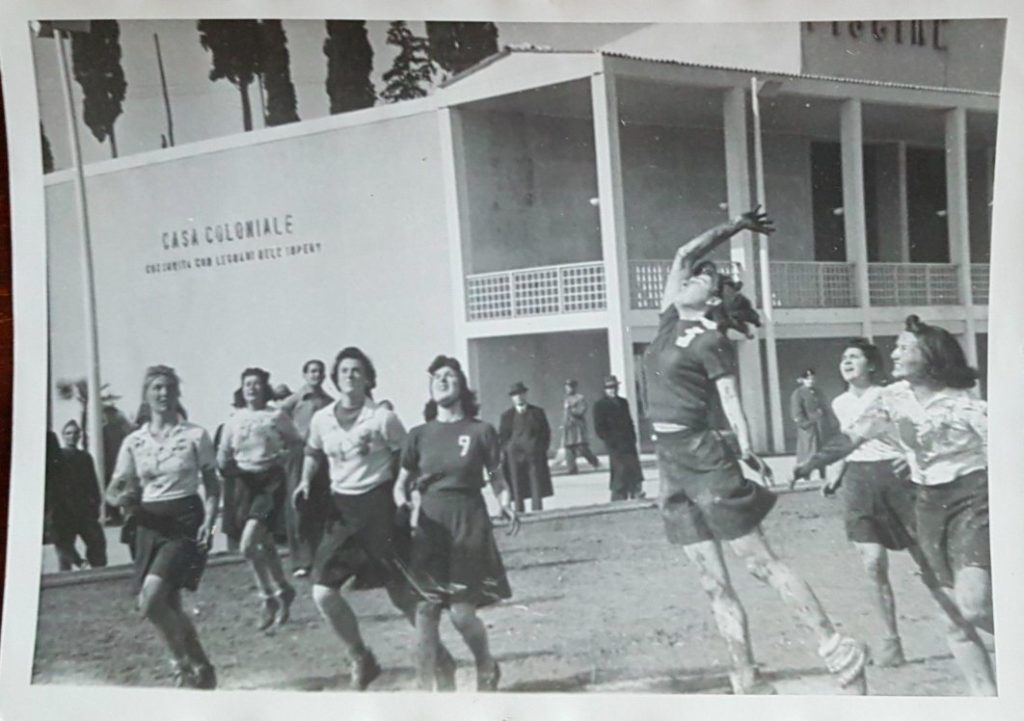
Parioli – Perugia during the semifinals of Coppa Bruno Mussolini (no date)
Source: https://twitter.com/calciatrici1933/status/1079364933626806275
In 1935 Bruno Mussolini joined the Italian Royal Air Force, becoming a pilot: he participated in Second Italo-Ethiopian War, Spanish Civil War, and World War 2. In 1941, while flying a bomber prototype, Bruno had a fatal accident, crashing into a house near the Pisa airport. Three members of the crew, including Bruno, died, and five of them, including Domenico, were slightly injured. In the last years of World War 2 Domenico joined the Repubblica Sociale Italiana, in the entourage of Vittorio Mussolini; and when he finally died, in 2002, he asked to be buried in the same Predappio cemetery where his old mate Bruno was buried (see https://bit.ly/3LkVbwo ).
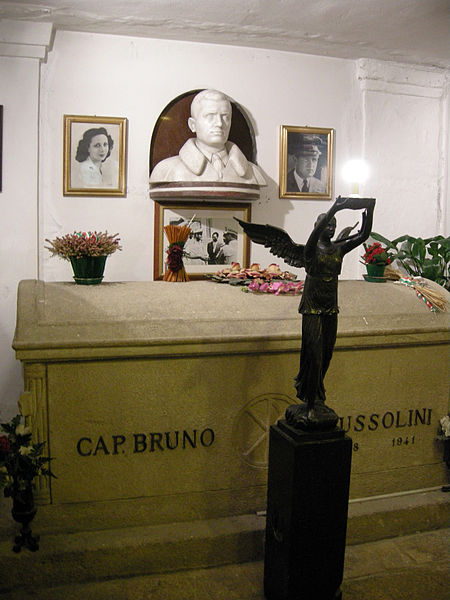
Bruno Mussolini’s tomb in the Mussolini’s family chapel, located in Predappio.
Source: Sailko, CC BY 3.0 <https://creativecommons.org/licenses/by/3.0>, via Wikimedia Commons
A propaganda short film about Bruno’s life and death (August 1941). Source: https://youtu.be/iZ96SgZuZjU

Bruno Mussolini was member of the 205ª Squadriglia da bombardamento, the Italian flight whose symbol was three little ‘sorci verdi’ or ‘green mice’
In Italian language ‘far vedere i sorci verdi’ – ‘to let show the green mice’ means ‘to strike back’.
The squadriglia motto was ‘diritti al segno’ – ‘straight at the target’.
Source: F l a n k e r, Public domain, via Wikimedia Commons
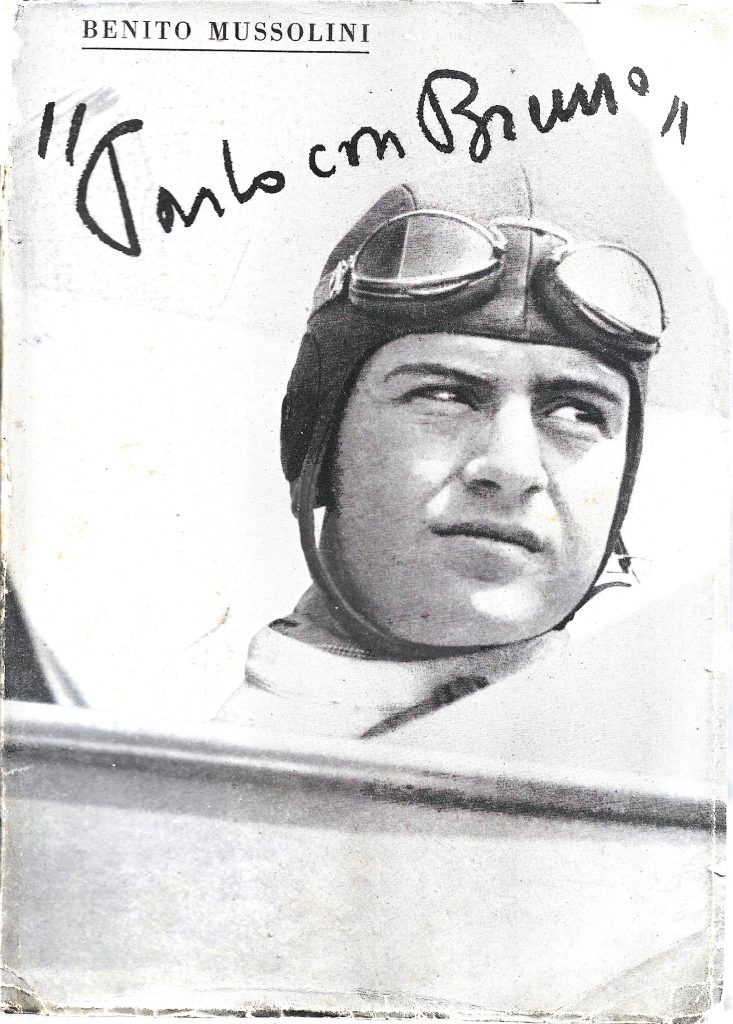
In 1941 Benito Mussolini’s himself wrote a book about his son’s death, entitled ‘Parlo con Bruno’ (‘Talking with Bruno’)
Source: Albertomos, CC BY-SA 4.0 <https://creativecommons.org/licenses/by-sa/4.0>, via Wikimedia Commons
The history of the Mussolini family members shed a further light on the media over-exposure of womens’ basketball in late 1930s’ Rome. During that age sportsmen and sportswomen had reductions on the cost of their rail transport, granted by the National Olympic Committee through a specific sport federation. Here you can see the card owned by Teresita Buvoli, granted by the FIP for her “athlete” status (that means, she was a basketball player). Teresita was sister-in-law of Vittorio Mussolini, because he had married her sister Orsola. In 1937 Teresita married Renato Tassinari, a Gazzetta dello Sport journalist, expert in motorsports; and on August 3rd 1938 he suddenly became the new editor of Il Littoriale, so perhaps no wonder that during those years this newspaper was so particular about the women’s basketball movement, especially the Roman one.
-
Teresita Buvoli’s rail reduction card
The date (26 August 1938) may suggest that Teresita got this card not for personal merit, but due to her husband’s influence
Source: https://twitter.com/calciatrici1933/status/1375956131445608451 .
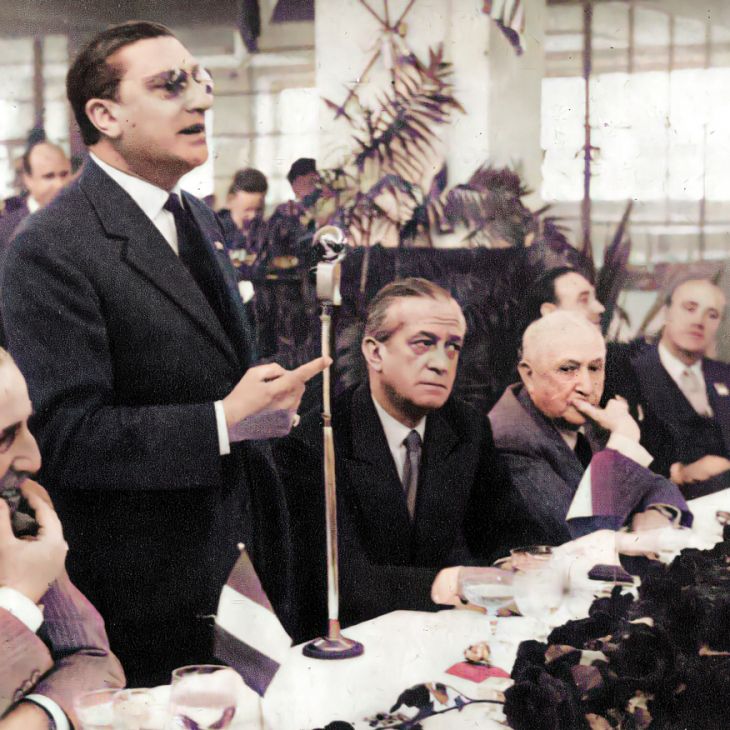
Tassinari during a speech, close to Enrico Piaggio. In 1949, he founded the first Vespa Club
Source: https://vesparace.it/articoli/renato-tassinari-il-primo-presidente-del-vespa-club-ditalia—i°-parte .
On the other hand, not all SS Parioli members were of noble origin: even sons and daughters of middle-class families often immigrated to Rome for job opportunities, joined the club. This seems the case of Vittorio Gassmann, the future actor, who was a great basketball player: born in Genua, the son of a German civil engineer and an Italian Hebrew woman, in 1926 the little Vittorio moved to Roma with his family. Member of the University National team, in 1942 Vittorio reached the final match of the men’s Divisione Nazionale, but his team lost against Reyer Venezia.
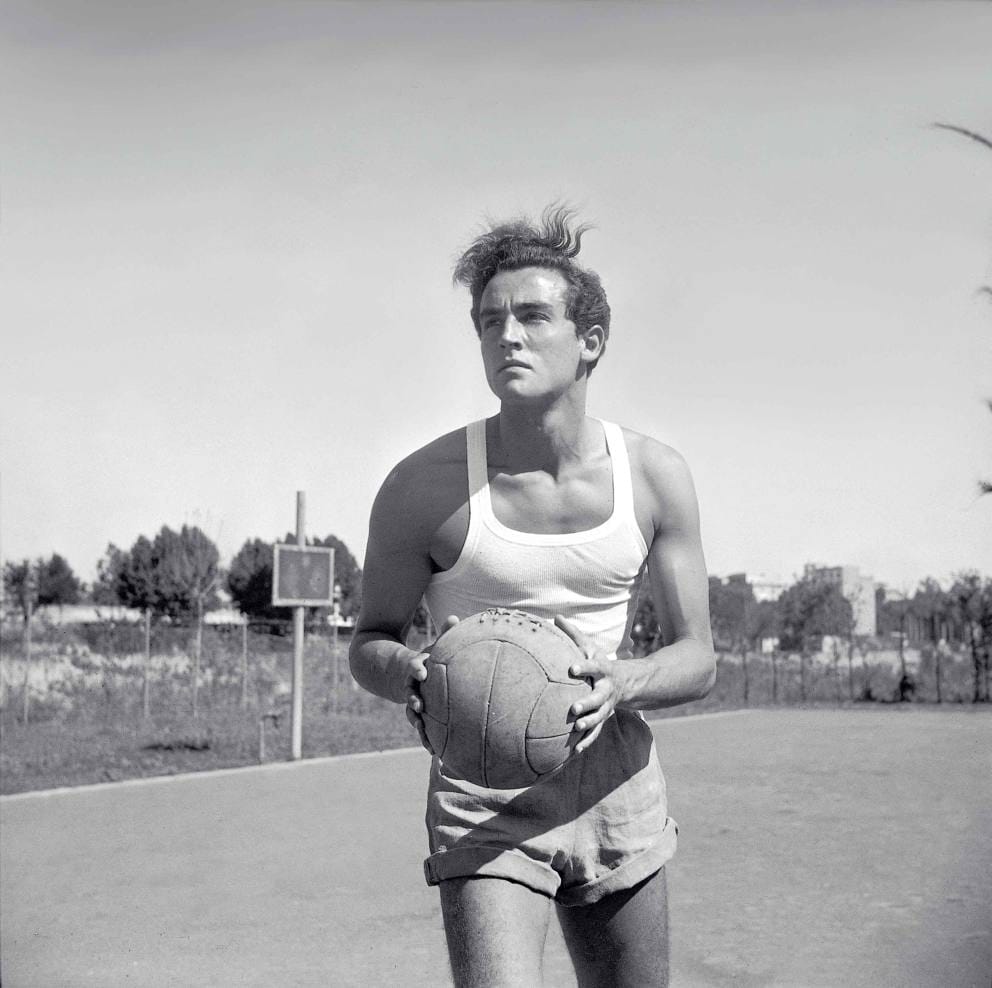
Vittorio Gassmann playing basketball
Source: https://bit.ly/3wHAcQ3 .
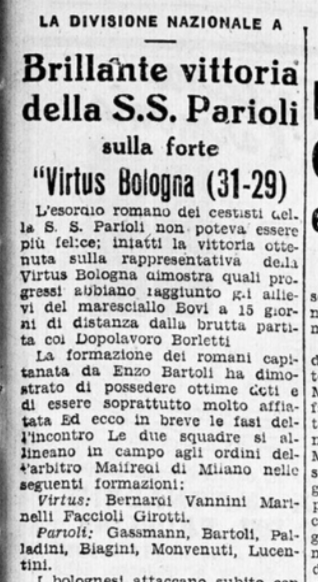
A 1940 match between SS Parioli and Virtus Bologna men’s basketball teams: note the name «Gassmann» in the players’ table
Source: Il Littoriale, 16/12/1940, p. 5
One last important fact about 1930s/1940s sports teams in Rome was that a lot of them were asked to play against teams from abroad, as a sort of mouthpiece of the entire Italian sports movement.
In 1935, the Parioli team from Rome hosted a double (female and male) match against their French opponents from Nice. Please note the difference between the French players’ shorts and their Italian opponents’ long skirts. Source: https://youtu.be/iGCBATXMNJU .
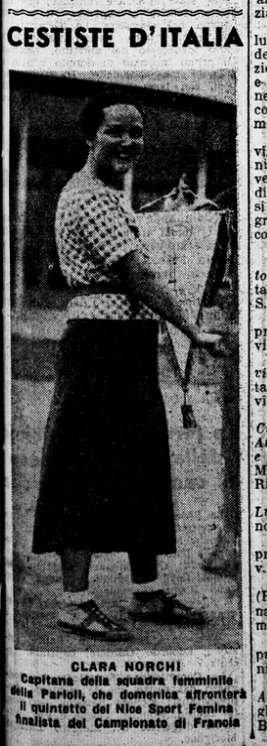
Clara Norchi
Captain of the SS Parioli, the team would play against Nice in June 1935
Source: 07/06/1935, p. 3.
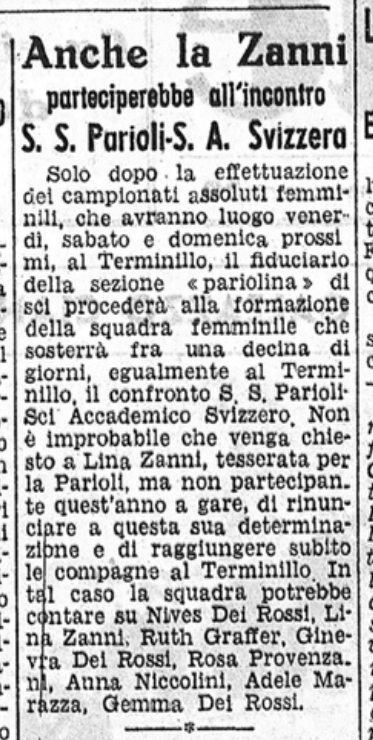
Also Parioli women’s skiers competd in international meetings, such as that of early 1940 among Parioli and the Academic Ski Club of Switzerland
Source: Il Littoriale, 29/02/1940, p. 2.
According to 1951 Bianculli’s article, coach Bovi (called ‘Maresciallo Bovi’ by everyone) noticed Giuliana, mostly for her height, bringing her into the Parioli cantera, where she met players such as Durantini, Norchi, Cristiani, Cerofolini, Giandolini, Ancherani. In 1939 season, the Parioli was still playing in Prima Divisione.
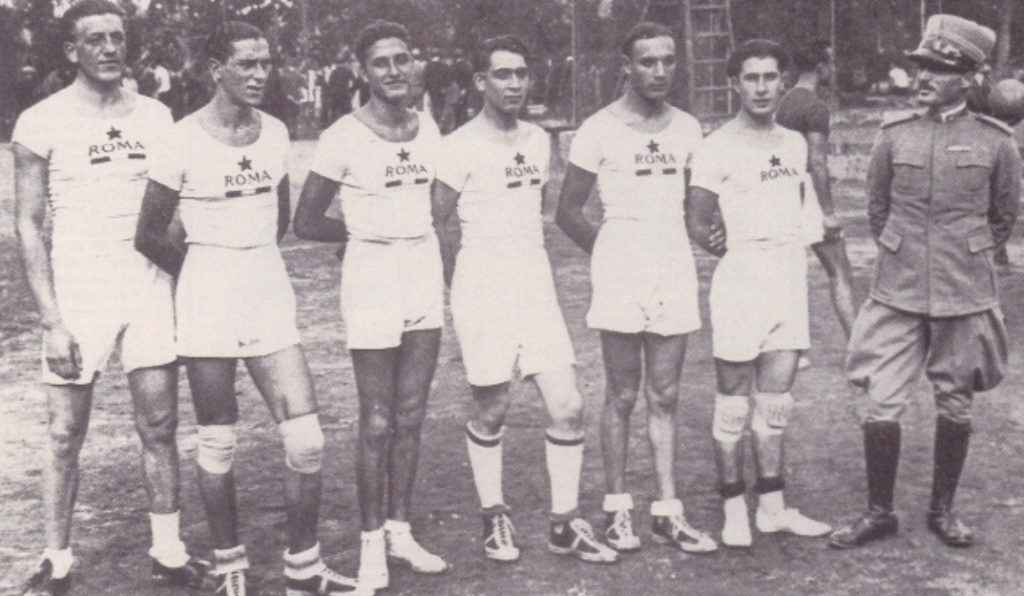
Maresciallo Bovi as trainer of 1929 Ginnastica Roma male baskteball team. As you can see, he was really a maresciallo ‘marshal’ (a military not commissioned officer rank of the Italian army) ! Source: https://www.museodelbasket-milano.it/leggi.php?idcontenuti=10
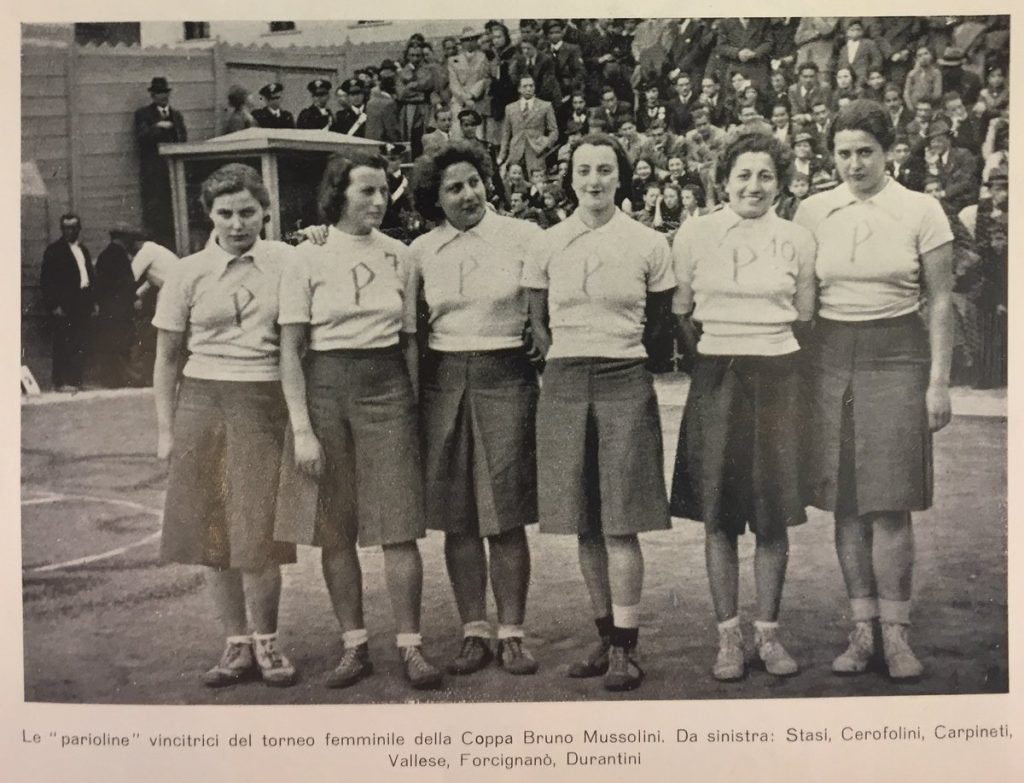
The Parioli line-up, winner of Coppa Bruno Mussolini (1938)
Stasi, Cerofolini, Carpineti, Vallese, Forcignano, Durantini
Source: Lo Sport Fascista, May 1938, p. 57.

A 1939 article about the match Napoli – Parioli
Source: Archivio privato Giuliana Bertea, p. 5.
In the 1940 season two women’s team from Rome joined the Divisione Nazionale: Parioli and GUF Roma (the university students’ team) – Ginnastica Roma didn’t. The first consisted of Clara Norchi, Silvana Ligozzi, Giuliana Bertea, Luciana Ancherani, Emma Zolfanelli, Dina Cristiani, Erminia Gori, Lora Gandolfi, Bianca Orlandi, Marcella Latini, Anna Maria Zenato and Liliana Mercuri; the second of Luciana Farri, Cecilia and Nicoletta Cipriani, Elena Migliore, Azzariti, Maccagno, Martella, Albertario, Giambartolomei, Trasi, Cortellessa and Donadona (see Mascolo 2016, pp. 61-62). Led by captain Claretta Norchi, the Parioli cestiste ‘women’s basketball players’ played a huge tournament, and the 19-years old Giuliana Bertea was praised by the Italian sports press for her high-performance game.
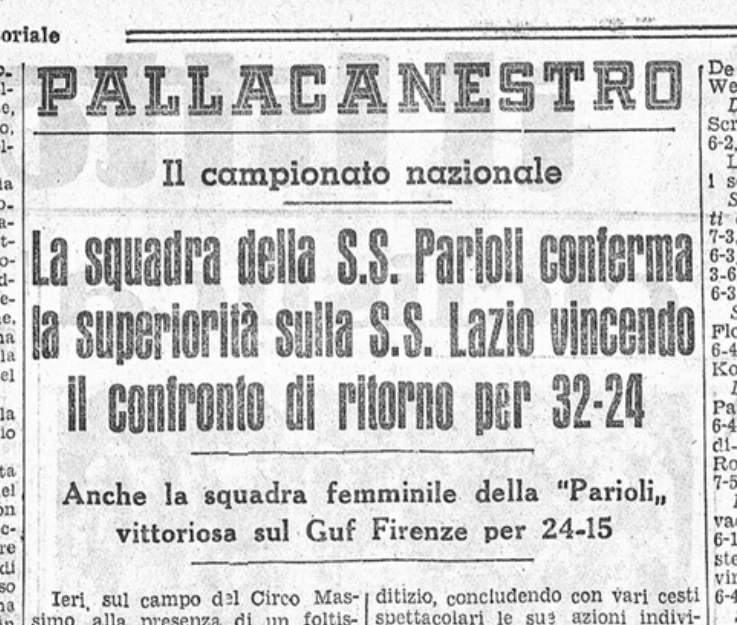
In March 1940, men’s Parioli team defeated SS Lazio (32-24), while the women’s team defeated GUF Firenze (24-15)
The main title is about the first victory, the smaller title about the second
The setting of this double victory was Circo Massimo!
Source: Il Littoriale, 25 marzo 1940, p. 5.
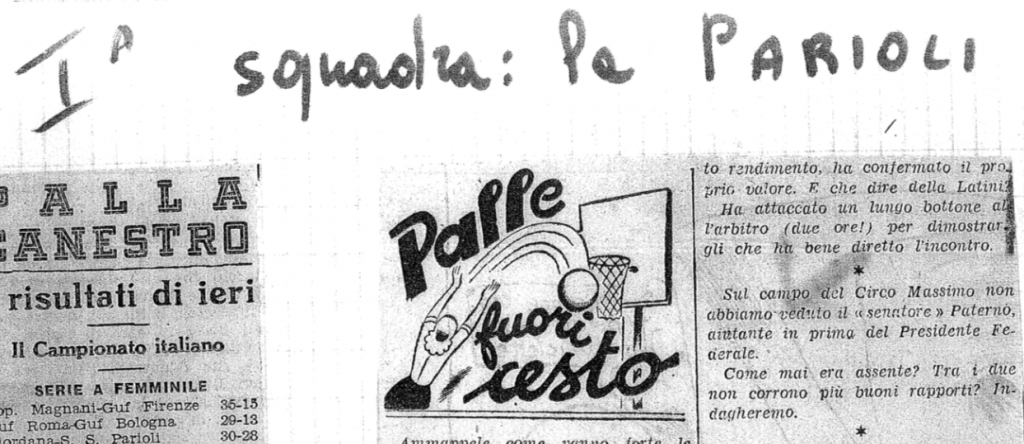
Please note that the icon of the both men’s and women’s basketball corner of this Italian newspaper shows a female player [The title means ‘Balls out of the Basket’
In Fascist Italy, basketball was perceived firstly as the girls’ game
Source: Archivio privato Giuliana Bertea, p. 4.
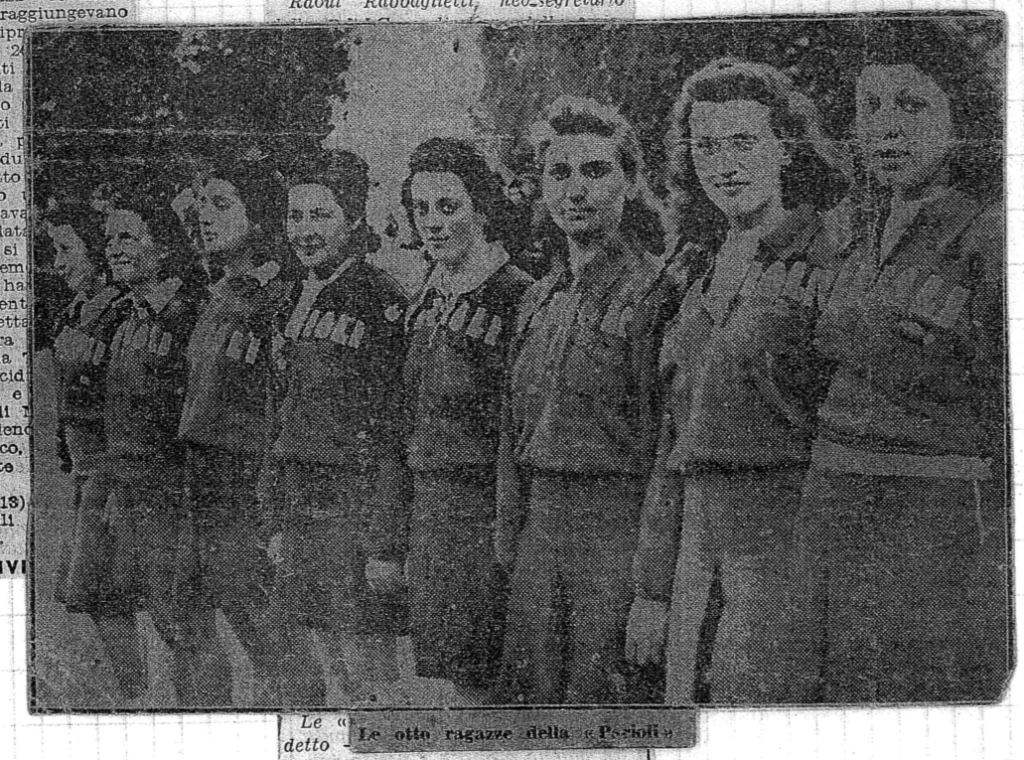
A Parioli team picture, probably taken in 1940
Giuliana is the third from the right: because of her blonde hair she is quite easily recognizable
Source: Archivio privato Giuliana Bertea, p. 4.
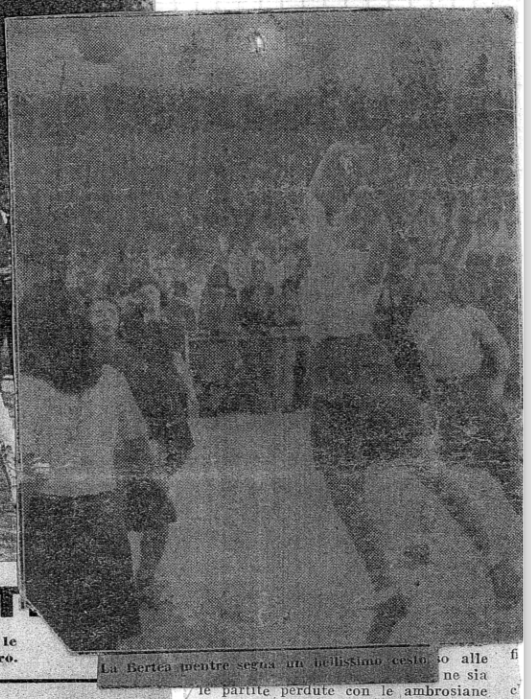
Giuliana making a basket during the 1940 finals
Source: Archivio privato Giuliana Bertea, p. 3.
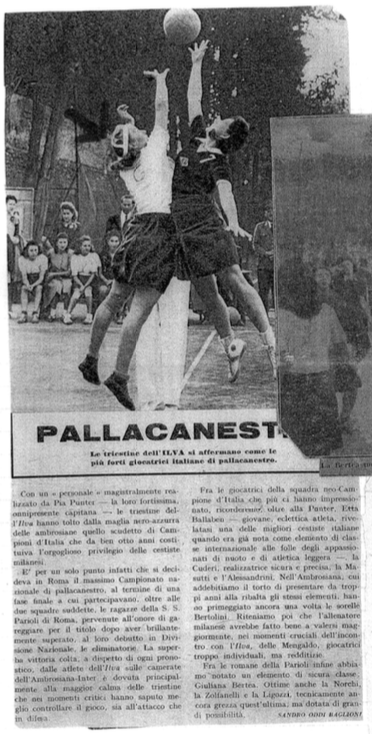
A clipping about the 1940 finals, won by Ilva Trieste
Source: Archivio privato Giuliana Bertea, p. 3.
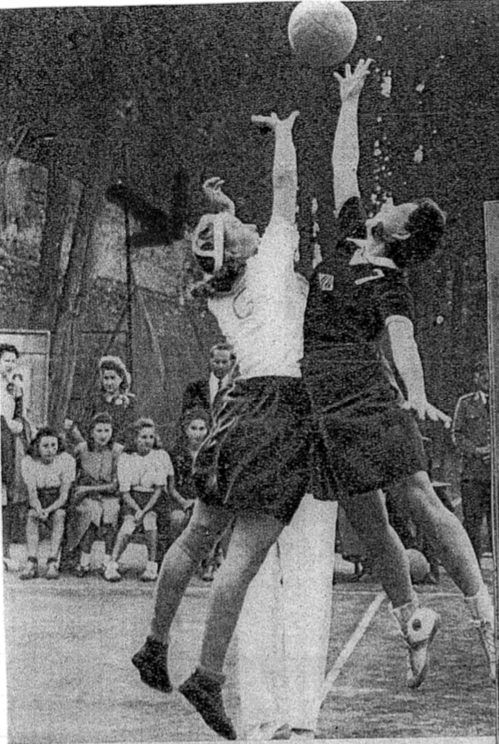
A tip off between Giuliana Bertea (see the handwritten arrow) and Etta Balleben (Ilva Trieste)
Etta Ballaben and her team won the Finals thanks to a free throw, 45 seconds from the end, during the last match against Ambrosiana Milano (23-22)
Source: Archivio privato Giuliana Bertea, p. 3.
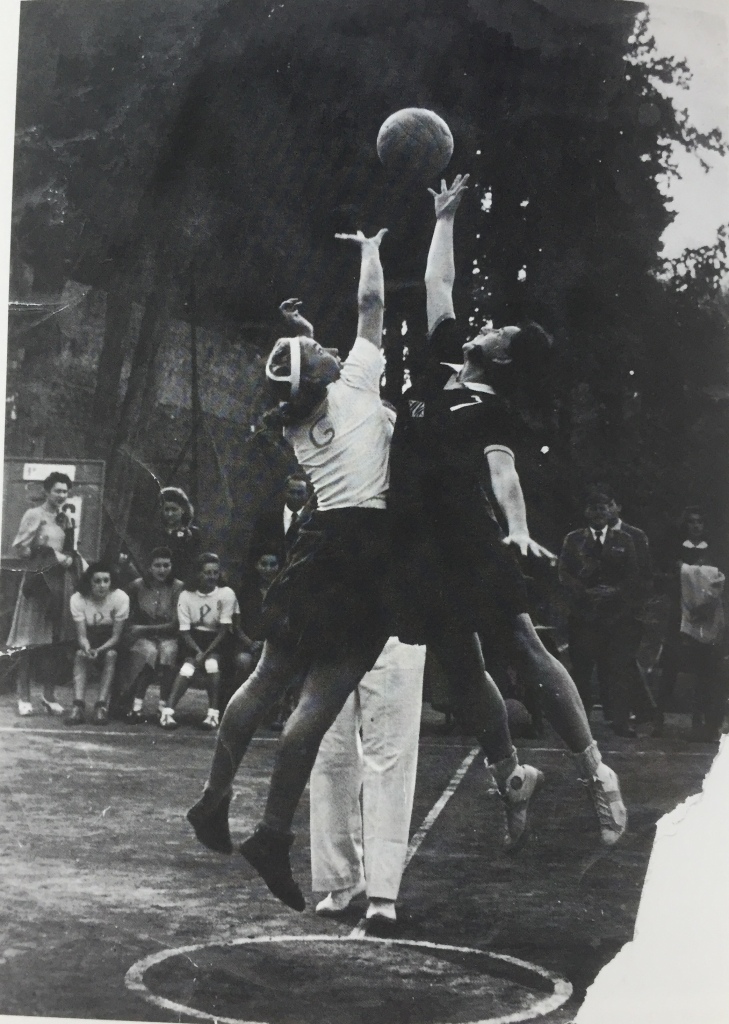
In this version we can clearly see Giuliana and Etta shirt numbers (6 and 7)
Giuliana would wear the number 6 for her whole career
Source: Silvio Maranzana, Ricordi della Pallacanestro Femminile Triestina, Trieste, Edizioni Pubbli-Service, 1993, p. 26.
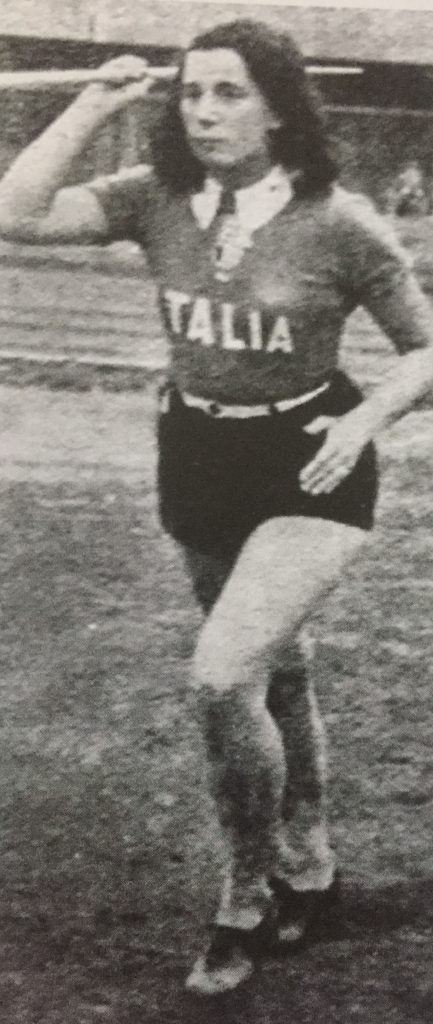
During the same year, Etta Ballaben became the National javelin champion
Source: https://twitter.com/calciatrici1933/status/1389598644479930374
The next two seasons (1941 and 1942) were quite bad, for the SS Parioli / Bruno Mussolini Roma team. Giuliana Bertea went on practicing several sports at the same time, and basketball wasn’t so important for her: during those years she became the regional foil champion. An undated clipping of this period says that Giuliana Bertea should not marry, because this would be a tragedy for the entire Roman sports movement, since she was not only the bomber of the Bruno Mussolini basketball team, but also foiler, gymnast, shot putter, so that the sports section of the local Fascist Federation would loose at the same not just one, but eight sportswomen!
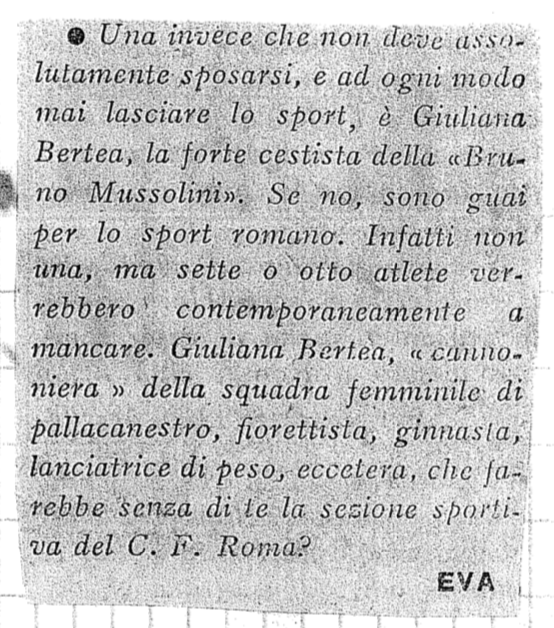
The ‘8 sportswomen’ clipping
Source: Archivio private Giuliana Bertea, p. 5.
A further clipping says that in October 1941, during the eliminatory rounds of the 8th edition of Coppa Bruno Mussolini, the coach of Bruno Mussolini Roma was harshly criticized for fielding very young players, 14 years-old on average. In fact, comparing the 1941 Parioli and 1942 Bruno Mussolini Roma players’ names (see Mascolo 2016, pp. 65-67) we can note a sort of revolution. Only 5 players (Luciana Ancherani, Giuliana Bertea, Bianca Orlandi, Luciana Turello, Emma Zolfanelli) remained, 9 left (Nazzarena Ancherani, Bugli, Mantovani, Liliana Mercuri, Clara Norchi, Rossi, Maria Teresa Scribanti, Clara Tampe, F. Turello) and 9 (Bianchi, Gallarini, Lora Gandolfi, Lia Lelli, Amelia Marchiaro, Rosina Micozzi, Anna Naccari, Peggion, Velia Vergano) entered in.Coach Maresciallo Bovi worked hard on building a new team: as a sort of reward for the work, in September the giovanissime ‘very young’ cestiste had the chance to travel to Switzerland, for a double match (Genève and Lausanne) against the Club Femine Atalante team.
-
The complete table of Giuliana Bertea’s teammates in Parioli (1940-1941), Bruno Mussolini (1942-1943), Indomita Roma (1946-1952)
Primary sources: Mascolo 2016, pp. 65-77; newspapers clippings (for 1946 and 1948 seasons).
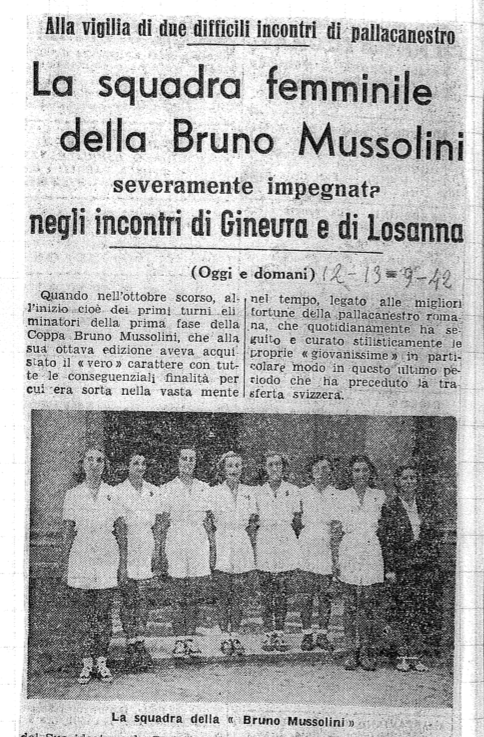
7 Bruno Mussolini Roma players before the two Swiss matches
The last woman might be one of the two female team assistants, Doctor Carini and … Mrs. Musti De Gennaro, called ‘ispettrice’ (Fascist female officer) by Il Littoriale
Was she the already married Enrica, or his mother?
Primary source: Il Littoriale, 12/09/1942, p. 4.
Source: Archivio privato Giuliana Bertea, p. 6.
On September 12th 1942 the Bruno Mussolini Roma cestiste played in Geneve against CF Atalante: some athletes of the home team were already known by the Italian press because they had already played Euro 1938 in Rome. Giuliana and mates were defeated 15-27 in front of the Italian Vice Consul and of the local Italian community; according to an Italian press, the fact that they used to play on clay (the Beauvivre court was asphalt-covered) was a big problem. One day later, Bruno Mussolini Roma and CF Atalante played again in Lausanne, on the occasion of the start of the local Fair. This time the Italians played on an even stranger basketball court, made of grass: yet they already knew their opposition, so they only lost 16-18: an honorable defeat, in front of the Italian Consul, for the very young cestiste led by the more experienced 21-years old Giuliana Bertea.
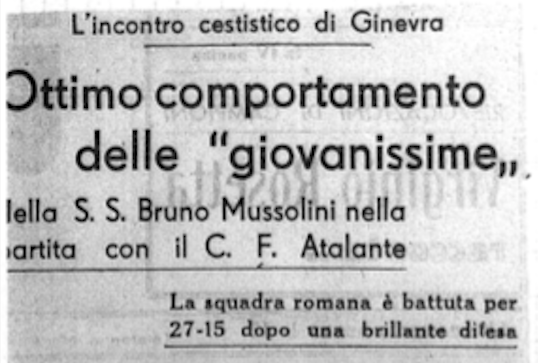
The title regarding the first match: ‘Excellent performance by the giovanissime’.
Source: Archivio privato Giuliana Bertea, p. 6.
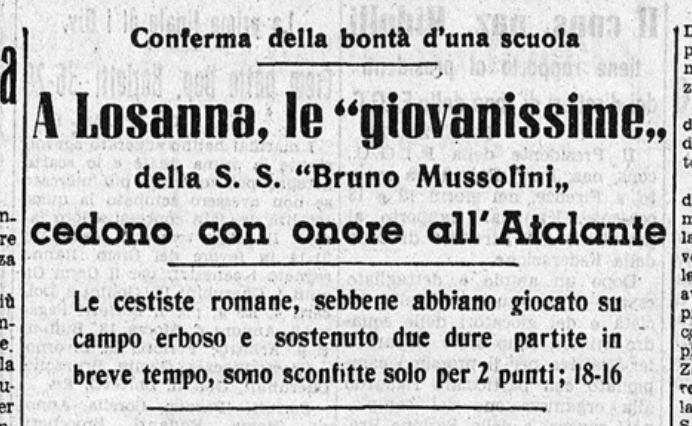
The title regarding the second match: ‘In Lausanne, the SS Bruno Mussolini giovanissime honourably defeated by CF Atalante’.
Source: Il Littoriale, 14 settembre 1942, p. 4.
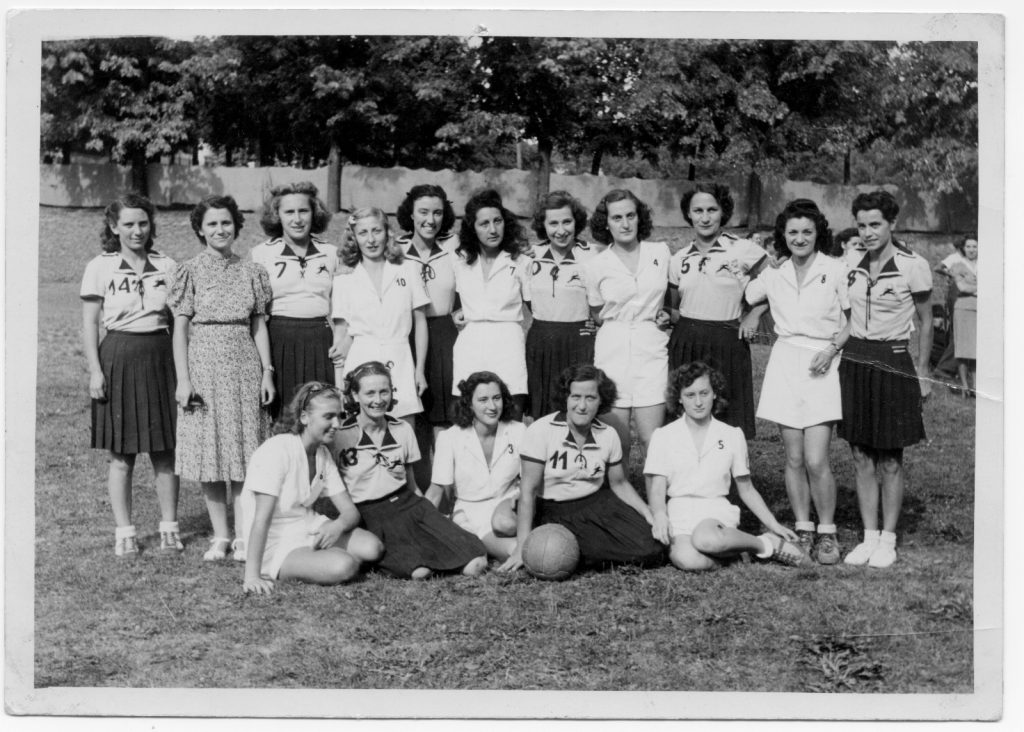
This photo, taken in Lausanne on 13/09/1942, depicts the Indomita Roma and CF Atalante players, together
Giuliana might be the first from left on the front row
Fun fact, Italians’ skirt looks even shorter than their opponents, although 4 years before, during EuroBasket 1938, the Switzerland players wore shorts (see http://www.fip.it/public/00fotom/foto66_svizzera.jpg ), not skirts!
Source: Archivio privato Giuliana Bertea.
The second international travel of 1942 was more influenced by the war situation. As Playing Pasts readers already know (see https://www.playingpasts.co.uk/articles/gender-and-sport/the-relay-runners-who-joined-the-resistance1930s-1940s-italian-athletes-lydia-bongiovanni-and-elda-francopart-3/ ), the Axis countries such as Germany, Italy and Hungary tried to build strong sports bounds, organizing a lot of international events among their National teams and clubs.
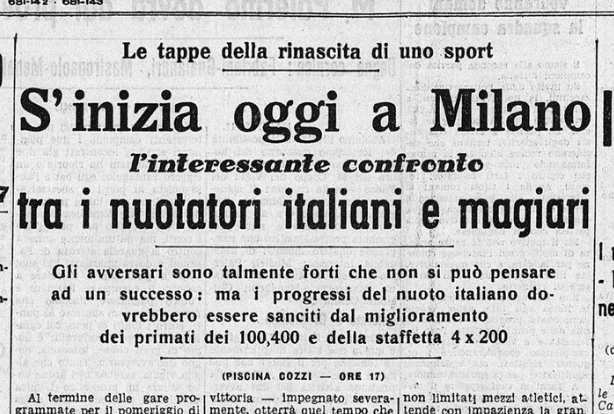
The meeting between the Hungarian and the Italian National swimming teams in Milan (September 1942)
Source: Il Littoriale, 12/09/1942, p. 1.
On 29th November 1942, the men’s Bruno Mussolini Roma players played at Horty Stadium in Budapest against the BSZ KRT players (who were Hungarian national champions), while women played against the BBTE team. The political meaning of this sporting event was given by the presence, among the audience, of representatives of the Italian Embassy in Budapest and of the local Italian Fascist Party. Among the Hungarian authorities were the son of Miklós Horty (the Regent of Hungary) and Alajos Béldy, the chief of Levente, the Hungarian Fascist-like youth mass association. Giuliana and her mates (Ancherani, Gandolfi, Marinello and Tampe) finished the first half time 13-24. During the second half time, the Hungarians almost equalized (30-32), but then the Italians won the match (32-35). Their male colleagues were later defeated 38-23.
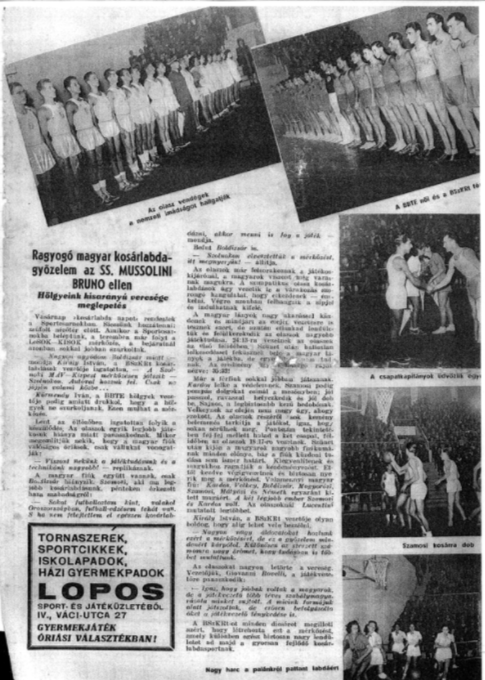
An Hungarian clipping about the Budapest match
Source: Archivio personale Giuliana Bertea, p. 6.
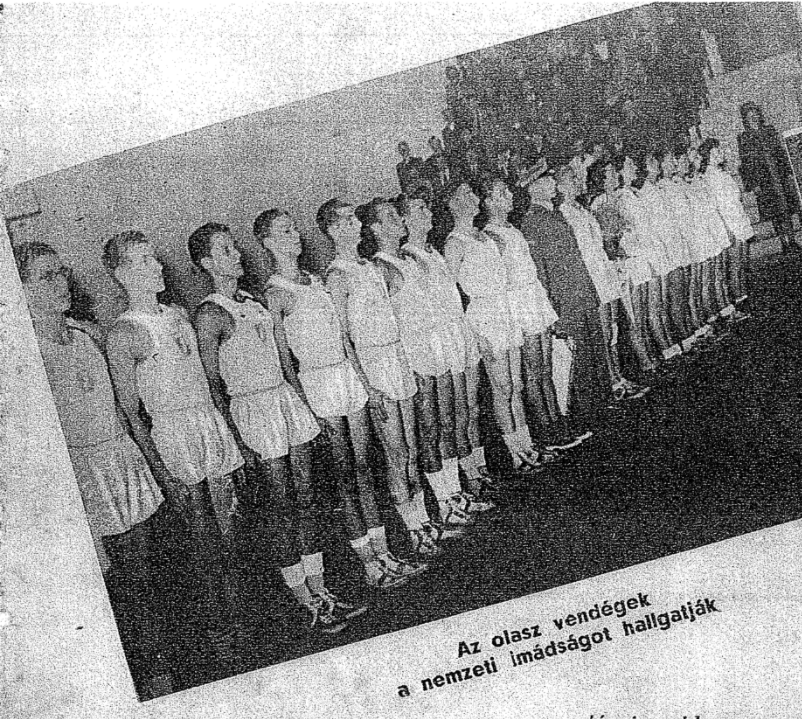
Men’s and women’s Bruno Mussolini teams, before the match
Please note that, despite of the different kind of sportswear, male shorts and female skirts had the same length, to mid-thigh!
Source: Archivio personale Giuliana Bertea, p. 6.
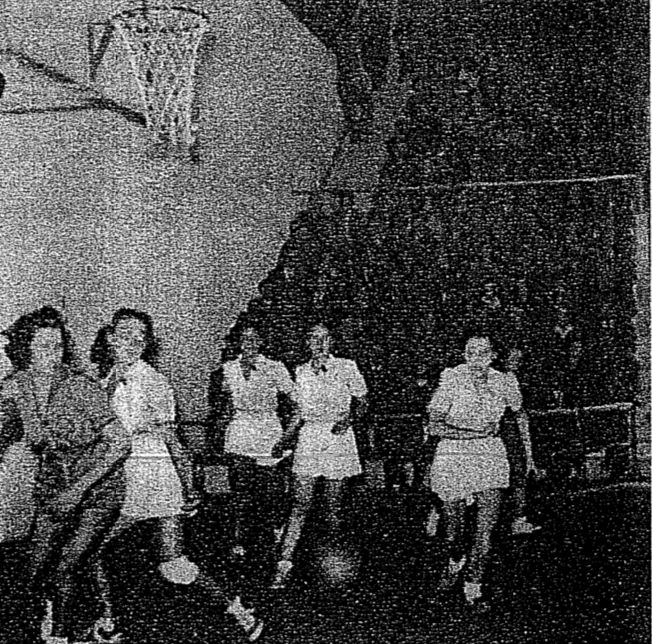
The only picture taken of the women’s match in Budapest
Source: Archivio personale Giuliana Bertea, p. 6.
That 1942/1943 season was even worse that the previous one: the Bruno Mussolini Roma team lost all Divisione Nazionale matches, which ended by June 1943. On July 25th, 1943 the Fascist regime ended … and probably the team had to change its name: but Giuliana Bertea’s album doesn’t tell anything about this. The only clue we have is a small clipping of an article written after Mussolini’s fall. In fact, the journalist talks about the already finished 1942/1943 season (he praised the Rari Nantes Trento cestiste), and then tries to list the players eligible to play in a new National teams. The fact is that all the club names after the players’ names are de-fascistized: the ‘GIL Bergamo’ becomes ‘Bergamo’, ‘GUF Napoli’ becomes ‘Napoli’, but ‘GUF Roma’ ‘Un. Roma’ (the GUF was the university Fascist group), probably because the ‘Bruno Mussolini Roma’ team becomes just ‘Roma’.
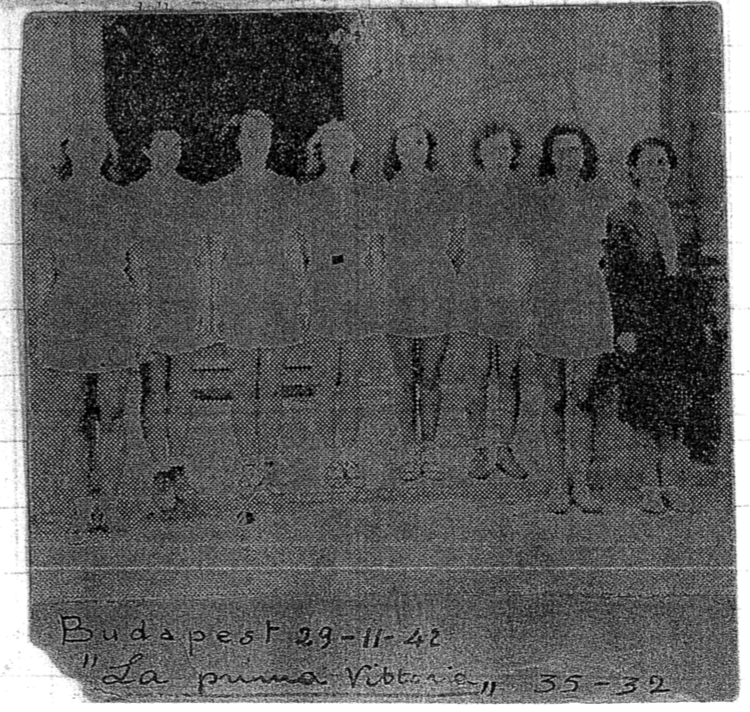
Giuliana wrote ‘the first victory’ on the clipping because in the first 4 matches of the 1942/1943 season, played all in November 1942, the Bruno Mussolini team had always lost, against FRIGT Torino (15-6, in Turin), Canottieri Milano (8-36), GUF Udine (24-18, in Udine) and GIL Bergamo (40-23, in Bergamo)
Source: Archivio privato Giuliana Bertea, p. 5
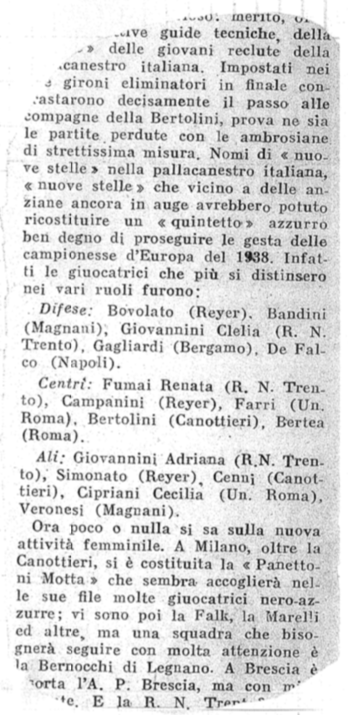
The mysterious clipping (late 1943?)
Source: Archivio personale Giuliana Bertea, p. 4.
We actually don’t know anything about Giuliana’s opinion about Fascism, neither in the late 1930s nor in 1943. Yet we can say that after the end of the war the juvenile militance into Bruno Mussolini Roma caused some trouble to male player Stefanini. As La Gazzetta dello Sport journalist Giorgio Fattori wrote, In the first days of January 1950, he was in Nice (France) with Italy’s National basketball team for an international tournament. While he was walking along a boulevard, Silvestrini was approached by a Spanish sportsman, who joyfully tapped on his shoulder, shouting with enthusiasm: “Te recuerdas Mussolini?” ‘Do you remember Mussolini?’. The man was a basketball player who wished to remind him of the Bruno Mussolini Spanish tournée that reached Barcellona around 1942: they had been introduced on that occasion. It was very simple, but the Spanish man was too concise, simplifying his reference to the basketball team, not to the Duce. Stefanini swallowed, answering that he remembered something, yet he was not really sure about it …
To Read Part 3 Please Click HERE
Article © of Marco Giani
For the digital edition of Giuliana Bertea’s album, see:
https://sorelleboccalini.wordpress.com/le-fonti_larchivio-privato-giuliana-bertea/
For more images about women’s basketball in Interwar Italy, see:
https://twitter.com/calciatrici1933/status/1072141225946480640

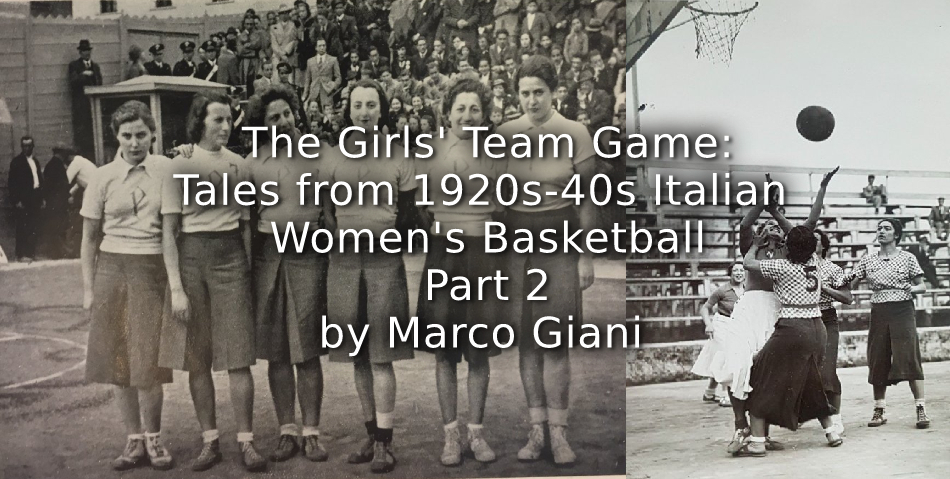
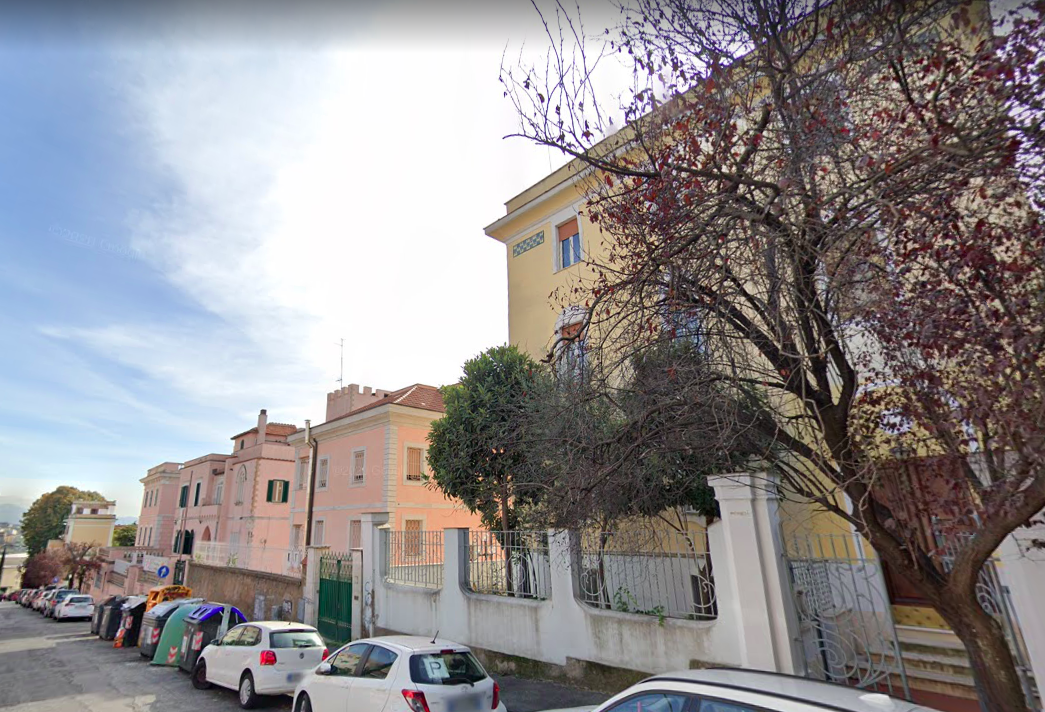
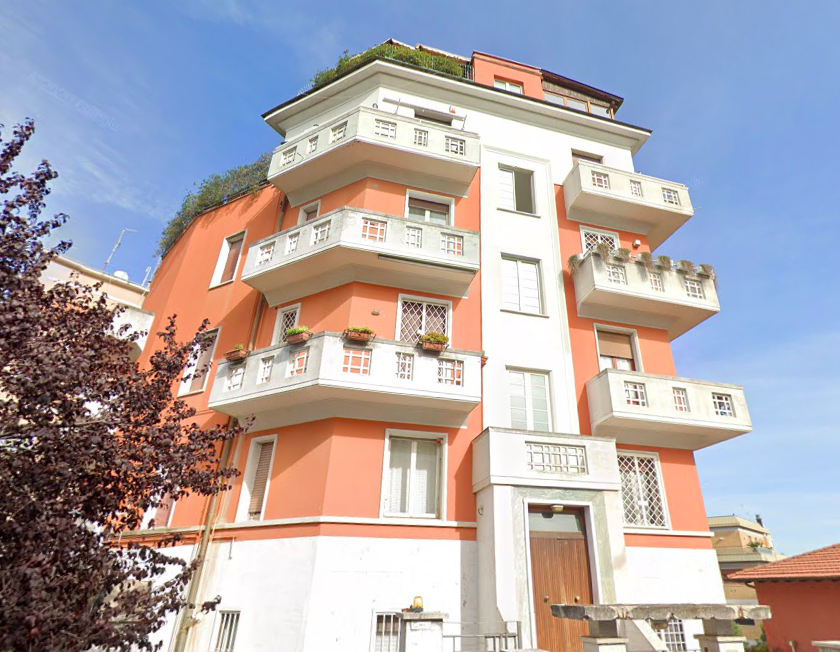

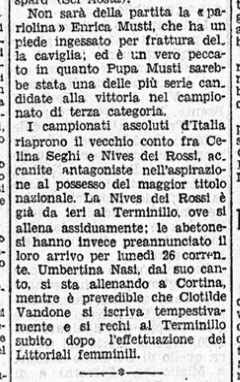
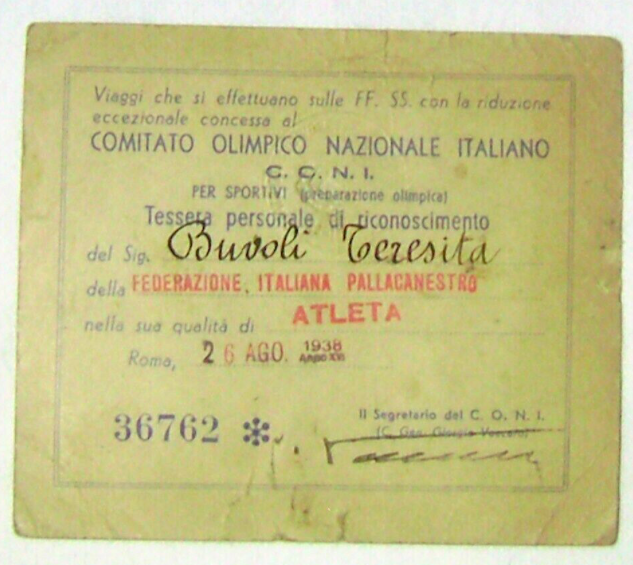
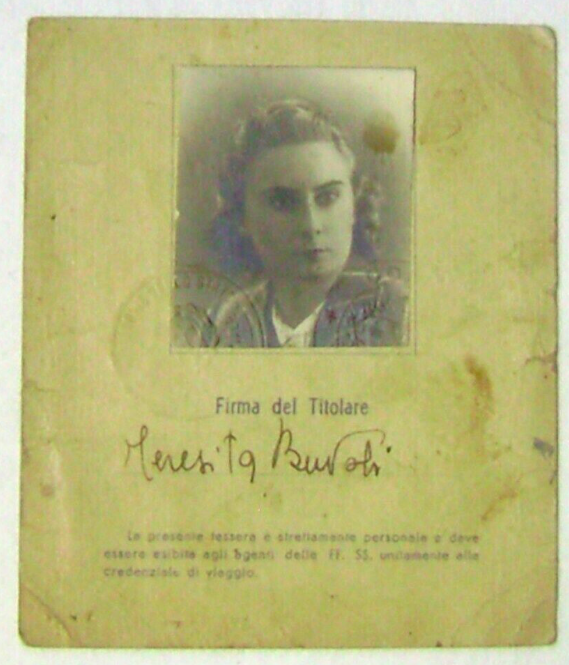
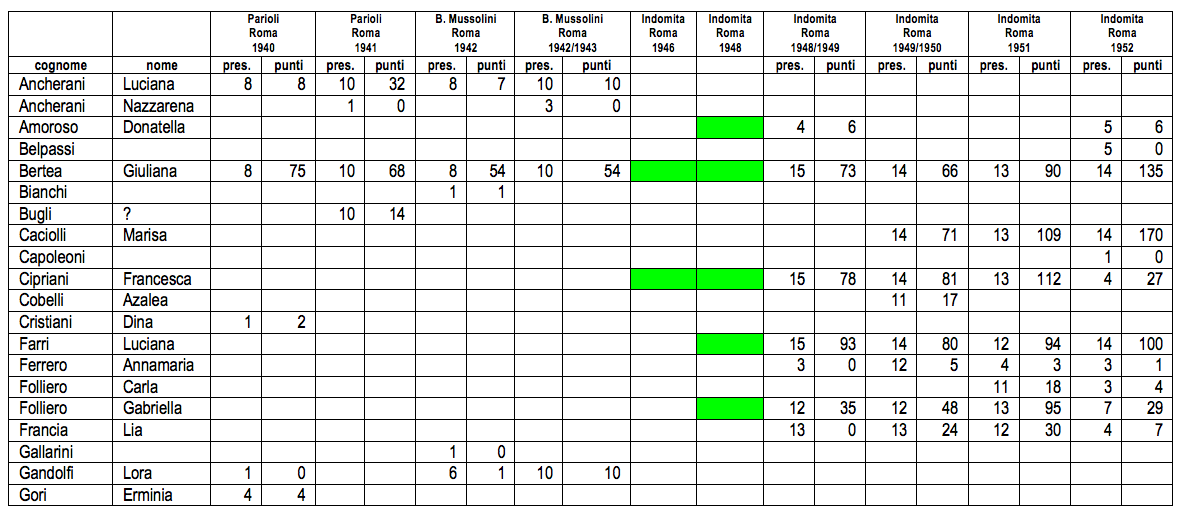
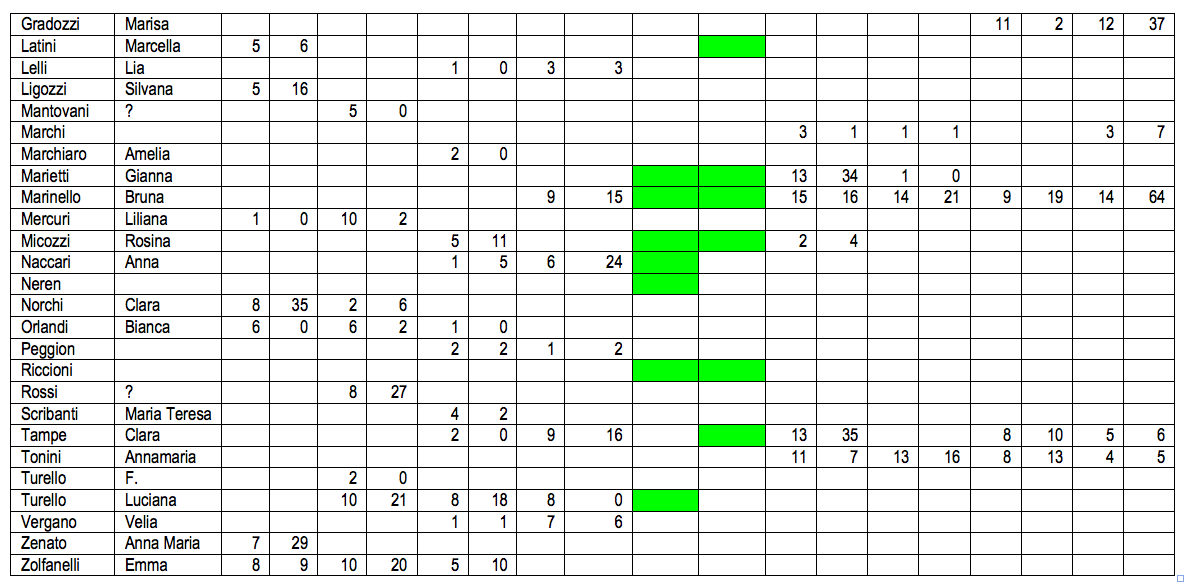

![“And then we were Boycotted”<br>New Discoveries about the Birth of Women’s Football in Italy [1933] <br> Part 9](https://www.playingpasts.co.uk/wp-content/uploads/2020/12/Boycotted-part-9-Marco-440x264.jpg)

